Planning an 11-day Ireland itinerary can be a pain in the backside… So, we’ve done all of the hard work for you!
We’ve spent 25+ years travelling around Ireland and the itinerary below leans on that experience and the many mistakes we made along the way!
In a nutshell, this 11-day itinerary:
- Has been meticulously planned
- Has an hour-by-hour itinerary for each day to save you time/hassle
- Follows logical routes that take you to hidden gems, tourist favourites and great pubs and restaurants
Who this itinerary will suit

Now, before you scroll down, take 10 seconds to look at the graphic above – each of our road trip itineraries have been tailored to specific needs.
This road trip is specifically for those of you:
- Starting in/near Knock
- Using your own car/a rental (if you’re renting a car, read this Irish car rental guide – it’ll save you time and hassle)
- Looking to explore at a fast pace
- With a low level of fitness (i.e. it avoids long walks and hikes)
- Remember, we have hundreds of different itineraries here if this one doesn’t suit you
An overview of this itinerary

Click here to see a high resolution map
The map above gives you a very high-level overview of where this route will take you.
It uses several bases (e.g. Dublin for 4 nights) and provides you with day-long road trips you can head off on, so you avoid having to change accommodation constantly.
Now, I’ll stop rambling on – here’s a day by day insight into each of the days below!
Day 1: Sligo’s history and beaches

Photos via Shutterstock
It’s day one and welcome to Ireland! Today, you’re heading up to Sligo Town from Knock Airport, where you’ll be doing some exploring of Ireland’s gorgeous northwest coast. You’ll spend two nights in Sligo before making your way to Westport.
If you haven’t already got somewhere in mind to stay, we’ve made a list of our favourite hotels and B&Bs in Sligo town below!
Our Sligo accommodation recommendations
- Budget: Old Fort B&B (great reviews and a 7-minute spin from town) and Tranquility B&B (solid reviews and 5-minute drive from town)
- Mid-range: Riverside Hotel (central with great reviews) and Sligo Southern Hotel (10-minute stroll into town and nice and comfy)
- Upper-range: The Glasshouse (right by the river in the town – close to everything) and the Clayton Hotel (5-minute drive to town with swimming pool)
Stop 1: Carrowmore Megalithic Cemetery

Photos via Shutterstock
From the airport, it’s a roughly 45-minute drive to the Carrowmore Megalithic Cemetery. This is a fascinating spot containing the country’s oldest and densest cluster of Neolithic tombs.
The site dates back over 6,000 years, with around 30 passage tombs still standing today (sadly, many were lost to quarrying and land clearance during the 18th, 19th, and 20th centuries).
At the centre of the cemetery, you’ll easily spot Listoghil or Tomb 51, by far the largest monument on the site at 34 metres in diameter. It’s the only tomb on the site clearly covered by a cairn and Megalithic art has been found under the roof slab!
The site is free to visit, but we recommend paying extra (around €5, cash only) for a guided tour and access to the exhibition in the restored cottage on site. Most people spend around one and a half hours here.
Stop 2: Lunch in Strandhill

Photos via The Strand Bar on FB
Drive the 10 minutes to Strandhill, a little seaside village, to grab some lunch. If you’re looking to kick off your holiday with some traditional Irish pub grub, then look no further than The Strand Bar.
They have all the classics and their Guinness beef stew is divine.
Dunnes Bar is our go-to for a mouth-watering burger, with heaps of options including two vegetarian burgers. If you’re in a group, then consider heading to Stoked for world-cuisine tapas.
They’ve got some bangers on the menu like Tandoori squid and lamb shoulder bao.
Stop 3: Coffee and a stroll on the beach

Photos via Shutterstock
If you’ve still got a little bit of room left, walk over to Mammy Johnstons for a coffee to go, followed by a leisurely stroll on the beach.
Strandhill Beach is a beautiful sandy beach with some great views of Sligo Bay and Knocknarea Mountain.
Coffee in hand, walk along the shore and explore the sand dunes or watch the surfers tackling the waves (it’s a popular surf spot throughout the year).
Although the water may look tempting (especially in the summer), Strandhill Beach is not a swimmer’s beach as there are dangerous rip currents further out.
Stop 4: Sligo Abbey
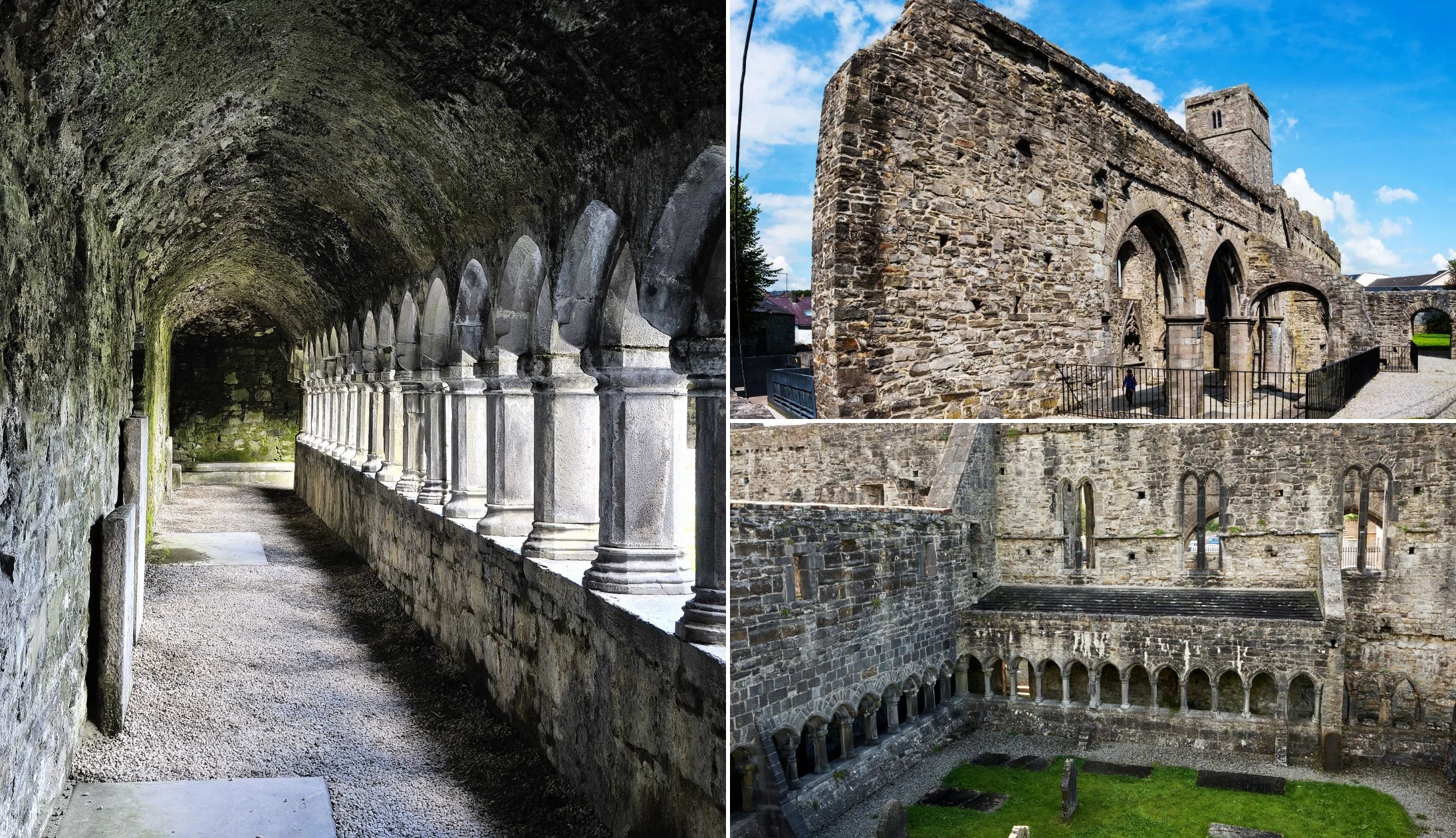
Photos via Shutterstock
Your next stop is Sligo Abbey, a 15-minute drive from Strandhill. The Dominican friary dates back to the mid-13th century and was founded by Maurice FitzGerald, the founder of Sligo Town.
The abbey ruins are in great condition considering they survived a fire in 1414; an attack during the ‘Nine Year War’ in 1595; and pillaging during the Rebellion of 1641. Legend has it that during the rebellion, the abbey’s silver bell was salvaged and thrown into nearby Lough Gill. Today, only those “pure of heart” can still hear the peal of the bell through the town…
Despite sustaining heavy damage, the abbey, which is a blend of Norman and Gothic architecture, still has beautiful carvings and monuments. For those interested in literature, the abbey was featured in two of W.B. Yeat’s poems – ‘The Curse of the Fires and of the Shadows’ and ‘The Crucifixion of the Outcast’.
The abbey is open daily with a small admission fee (around €5).
Stop 5: Yeats building

Photos courtesy Eddie Lee/Ed Lee Photography via Failte Ireland
If you’ve an interest in Irish culture, take the short, 6-minute stroll to the Yeats Building. It’s here that you’ll be immersed in all things drama, history, literature and poetry.
There’s a Yeats exhibition that’ll take you into the mind of one of Ireland’s most famous poets and you can also take a guided tour (advance booking needed).
Stop 6: Dinner, drinks and live music

Photos by The Irish Road Trip
It’s time to wrap up your first day, and what a day it was! Head back to your hotel to freshen up, or go directly from the museum to grab some dinner. We’ve got some suggestions below.
Our Sligo food recommendations
Hopefully, you’re hungry as there’s some excellent restaurants in Sligo.
Head to Hooked for delicious Irish and international food made from local ingredients sourced from Sligo County. Some of our favourite dishes are the Sherlock of Tubbercurry’s prime beef steak sandwich and the buffalo chicken mac’n’cheese, but they also have some delicious vegan and vegetarian dishes.
For seafood and steaks, we love Coachlane. It’s a little on the pricey side, but their certified Irish Angus beef is worth the extra money. If steak isn’t your thing, their seafood platter is incredible, with salmon, scallops, crab claws, cod, monkfish, and shrimp.
Our Sligo pub recommendations
If you’re feeling like after dinner drinks, we suggest hitting up Hargadon Bros (a traditional Irish pub dating back to 1868), Thomas Connolly (a heritage Irish pub and the oldest in Sligo Town), and Shoot the Crows (a cosy and quirky traditional pub with a great pint of Guinness).
For a night of lively trad music, pass by McLynns Bar or Fureys Pub (or both!).
McLynns is in the heart of Sligo town on Old Market Street. The fourth-generation pub has been running since 1889, with live music (Irish folk, acoustic, and bluegrass) every weekend and on mid-week nights. The traditional interior will transport you back in time, with wooden furniture and historical decor.
Fureys Pub on Bridge Street is a cosy old-style pub with a great atmosphere, an open fire (great for those cold winter evenings), and live trad music on weekends and certain weekday nights.
Day 2: Sligo – Yeats Country
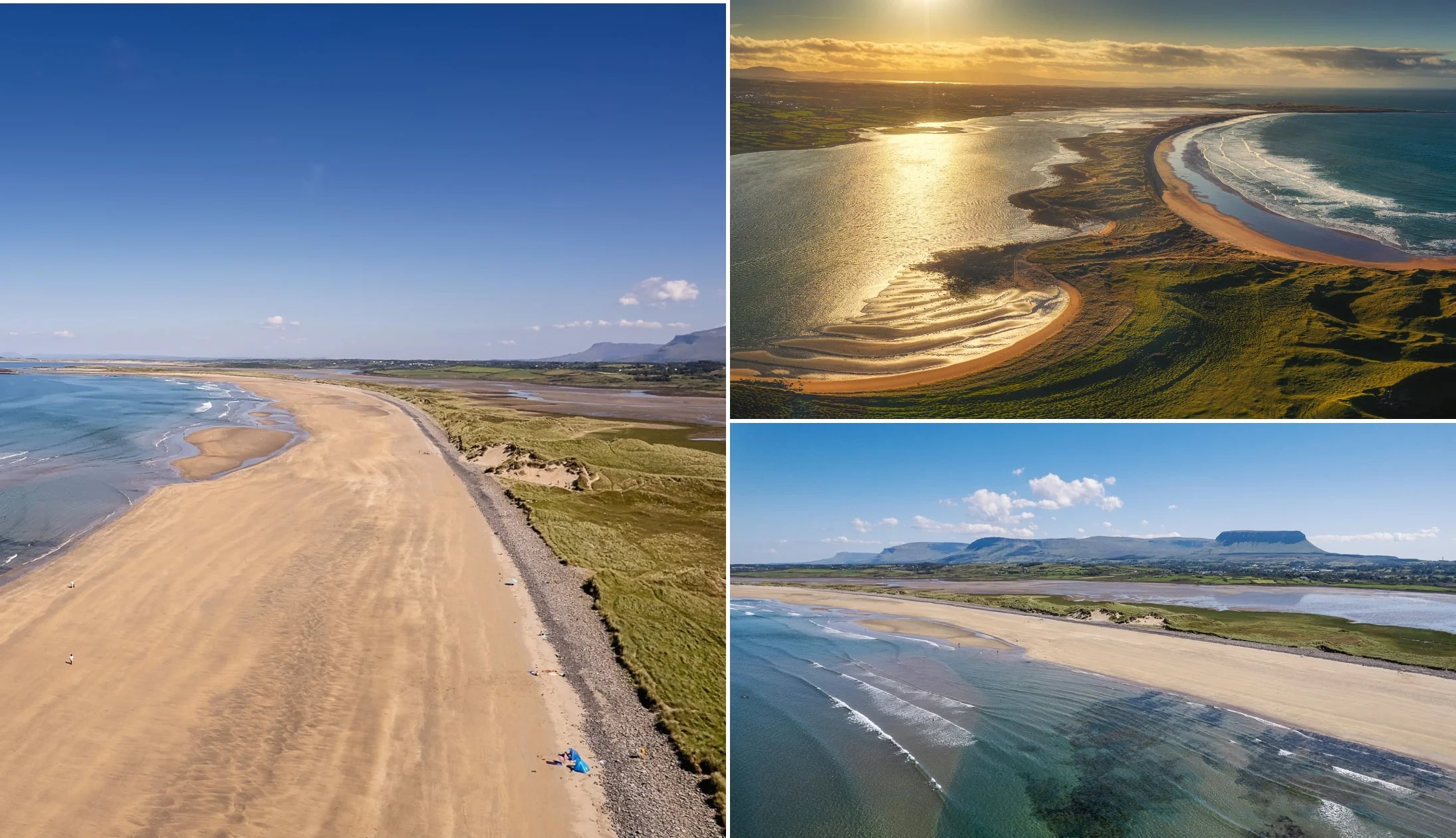
Photos via Shutterstock
Today we are exploring more of Sligo. Just a note on today, we have you drive back to Sligo to grab some lunch before heading back out to Lissadel house.
If you want to cut down on driving time today, we recommend that you drop into a Centra, Spar, or SuperValu and grab a sandwich or packed lunch to keep in the car with you.
Start the day with a hearty breakfast at your accommodation. Or if you want to have breakfast out, we recommend Margarets Cafe (a cosy spot with traditional Irish breakfast, french toast, and pancakes) or Lyons Cafe and Bakeshop (hearty cooked breakfasts and artisanal pastries).
Stop 1: The Model

Photos courtesy Eddie Lee/Ed Lee Photography via Failte Ireland
Sligo is officially Yeats country, so it’s a great opportunity to learn about/see works by both brothers. The Model is a wonderful contemporary art gallery and centre in the heart of Sligo town.
It’s home to the Niland Collection (named after the librarian who founded the collection in the 1950s, Nora Niland), with over 300 works, including a significant collection of Yeats pieces.
‘A Political Meeting (In the West of Ireland)’, ‘A Sunday Morning in Sligo’, and ‘An Island Man’ are just a few of the J.B. Yeats works in the collection. Each year, the gallery curates six exhibitions from the Niland Collection, with a heavy focus on the works of J.B. Yeats.
Stop 2: Drumcliffe Church and WB Yeats Grave

Photos via Shutterstock
After The Model, hop in the car and drive the 10 minutes to Drumcliffe Church (also known as St. Columba’s Church).
This beautiful church is renowned for being the location of W.B. Yeat’s grave (although it wasn’t his first resting place!). His simple grave is in the churchyard, with an inscription reading, “cast a cold eye on life, on death, horseman, pass by”, written by the poet himself.
The church is in a stunning location, in front of Benbulben Mountain, amongst lush green fields. There’s free parking on-site, and if you’re already hankering for another coffee, there’s a little coffee shop.
Stop 3: Glencar Waterfall
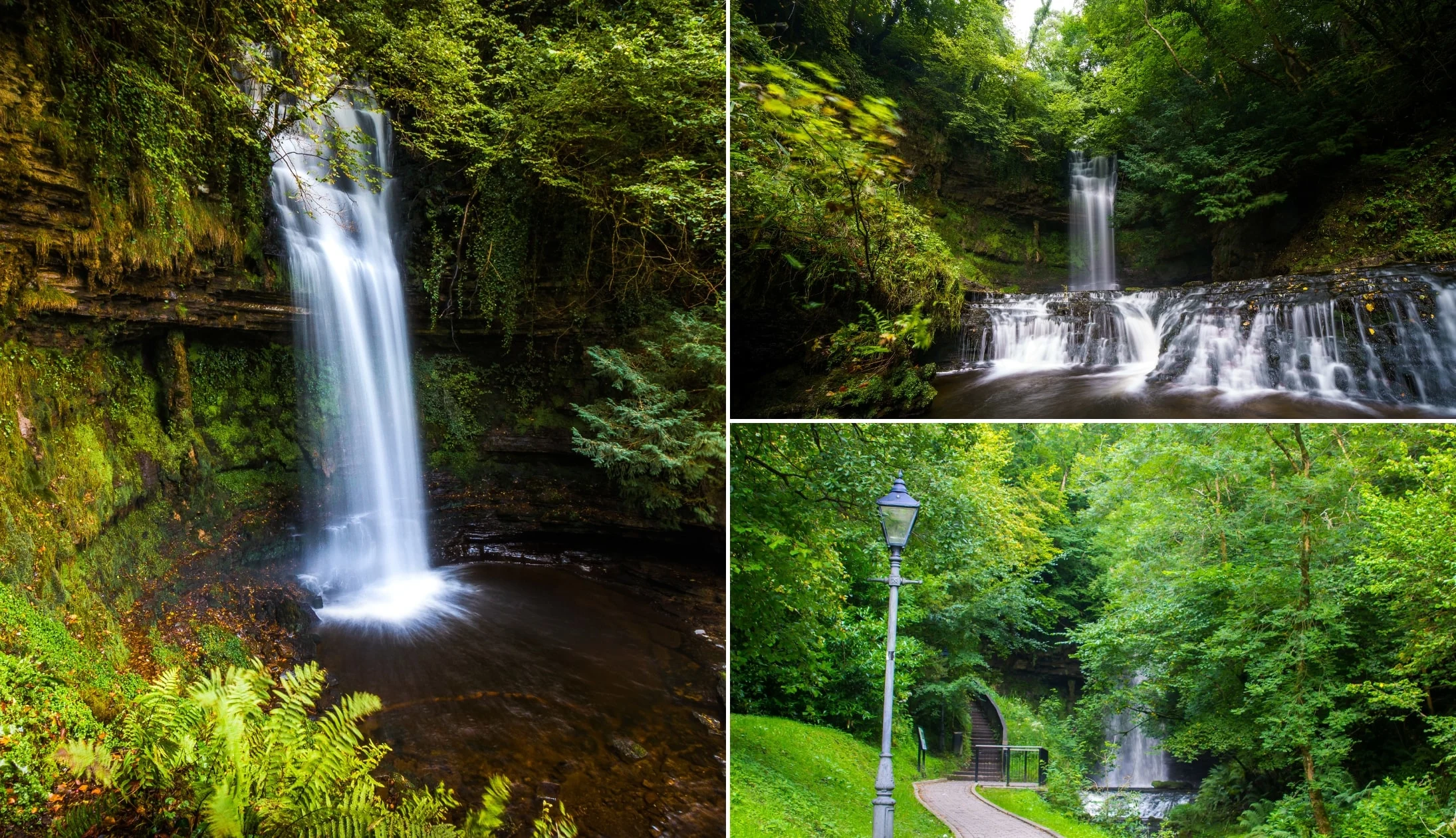
Photos via Shutterstock
Okay, so Glencar Waterfall is technically in Leitrim, but since it’s only 16 minutes from the church and right on the Sligo border, we had to include it!
Glencar Waterfall is a magical place and the inspiration for W.B. Yeat’s poem ‘The Stolen Child’. The waterfall, a lovely little cascade, is tucked away within an enchanting forest, only a five to 10 minutes walk from the car park.
There’s plenty of parking there, so there’s usually no trouble finding a space.
Stop 4: Back to Sligo for Lunch (optional)
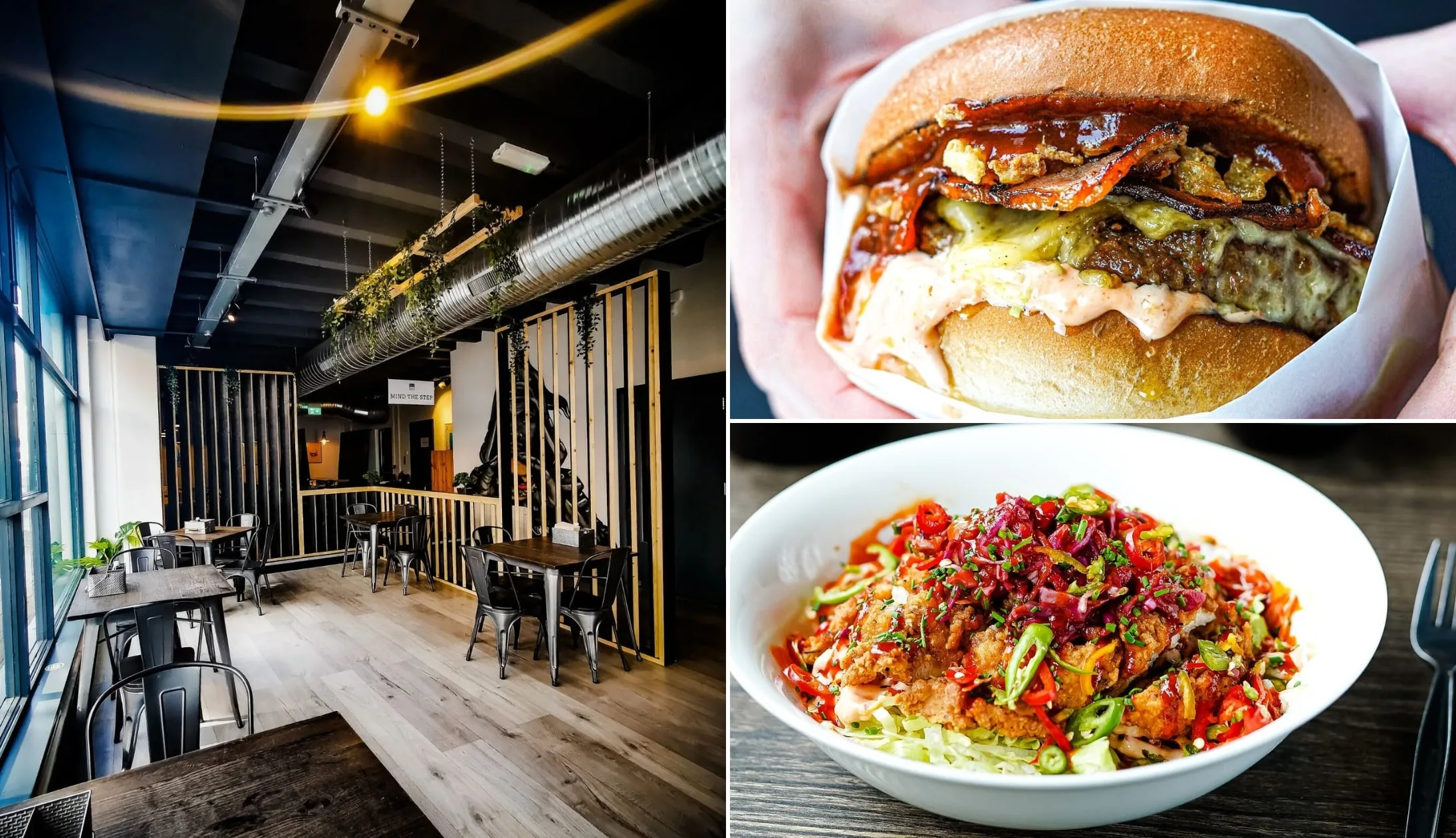
Photos via Flipside Sligo on FB
If you didn’t opt to grab a packed lunch this morning, then drive the 17 minutes back to Sligo town for a cooked meal.
Our personal favourite lunch spot is Hooked (which we recommended last night for dinner). Their brunch menu has Irish classics like beer-battered fish and chips and international dishes like the 12-Hour Slow Cooked Pork Belly Vietnamese Bahn Mi.
If Hooked doesn’t take your fancy, then we also recommend Lyons Cafe and Bakeshop or Bridgefoot House.
Stop 6: Lissadell House

Photos via Lissadell House on FB
Kick off the afternoon with a visit to Lissadell House, a 19-minute drive from Sligo Town or Glencar. The neo-classical Greek revivalist home dates back to 1830 and was completed in 1835.
The original 32,000-acre estate belonged to the Gore-Booth family and was the childhood home of Constance (who would become Countess Markievicz, a famous Irish revolutionary) and Eva Gore-Booth (a poet and suffragette), alongside their three siblings. The Yeats brothers also visited the home on holiday, with W. B. Yeats referencing the home and the famous sisters in his poem “In Memory of Eva Gore-Booth and Con Markiewicz”.
Today, the now 500-acre estate and home are privately owned, although it is open to the public. There’s lots to do, whether it’s taking a stroll through the 2.5-acre garden, admiring the lavish rooms, seeing the 1916 exhibition, or visiting the Yeats Gallery, which contains works of painter Jack B. Yeats.
Stop 5: Streedagh Beach stroll

Photos via Shutterstock
Hop in the car and make your way to Streedagh Beach, a 15-minute drive away. There’s a large car park there, so you usually don’t have to worry about finding a spot.
The beach itself is an impressive 3km long sandy stretch on a sandbar that links the mainland to Connor’s Island. We think the beach probably has the best view of Benbulben Mountain in the county, and you may recognise it from the TV show, Normal People.
It’s a lovely spot for a ramble to take in the fresh sea air and the amazing views. During the summer, there’s a lifeguard service, although we advise against swimming unless you’re experienced as the waters have strong tides and undercurrents.
Stop 6: Back to Sligo town for the evening

Photos by The Irish Road Trip
It’s time to call it a day and head back to Sligo town. It’s around 22 minutes in the car, and you may want to stop by your accommodation to freshen up before dinner, or, if you’re really hungry, go straight to the restaurant!
Our Sligo food recommendations
Hopefully, you’re hungry as there’s some excellent restaurants in Sligo.
Head to Hooked for delicious Irish and international food made from local ingredients sourced from Sligo County. Some of our favourite dishes are the Sherlock of Tubbercurry’s prime beef steak sandwich and the buffalo chicken mac’n’cheese, but they also have some delicious vegan and vegetarian dishes.
For seafood and steaks, we love Coachlane. It’s a little on the pricey side, but their certified Irish Angus beef is worth the extra money. If steak isn’t your thing, their seafood platter is incredible, with salmon, scallops, crab claws, cod, monkfish, and shrimp.
Our Sligo pub recommendations
If you’re feeling like after dinner drinks, we suggest hitting up Hargadon Bros (a traditional Irish pub dating back to 1868), Thomas Connolly (a heritage Irish pub and the oldest in Sligo Town), and Shoot the Crows (a cosy and quirky traditional pub with a great pint of Guinness).
For a night of lively trad music, pass by McLynns Bar or Fureys Pub (or both!).
McLynns is in the heart of Sligo town on Old Market Street. The fourth-generation pub has been running since 1889, with live music (Irish folk, acoustic, and bluegrass) every weekend and on mid-week nights. The traditional interior will transport you back in time, with wooden furniture and historical decor.
Fureys Pub on Bridge Street is a cosy old-style pub with a great atmosphere, an open fire (great for those cold winter evenings), and live trad music on weekends and certain weekday nights.
Day 3: The Mayo Coast

Photos via Shutterstock
Today we’re heading to Westport, the long way round. Along the way, we’ll take in the stunning Mayo coast and the sights of Achill Island, one of the country’s most remote areas and Ireland’s largest island.
There’s going to be a lot of driving today, but it really is the only way to see all of the incredible places we’ve got lined up for you! Be sure to drop by a shop before you leave Sligo to grab plenty of snacks and water for the car.
Before hitting the road, let’s grab one last breakfast in Sligo, either at your accommodation or one of the many fantastic cafes in town. Margaret’s Cafe does a wonderful full Irish, but their pancakes and smoked bacon are also well worth giving a go. For a vegan-friendly alternative, head to Sweet Beat, where you’ll find an extensive menu and great coffee.
You’ll need to book three nights’ accommodation in Westport, so be sure to check out our suggestions.
Our Westport accommodation recommendations
- Budget: Old Mill Holiday Hostel (in the town with good reviews) and Clooneen House (very central with excellent reviews)
- Mid-range: Castlecourt Hotel (very central and has a spa) and Westport Plaza Hotel (central with exceptional reviews)
- High-range: Knockranny House (gorgeous hotel a 1-minute drive from town)
Stop 1: Grab a cup of coffee and stretch your legs in Ballina

Photos via Shutterstock
Our first stop takes us to the riverside town of Ballina, about an hour’s drive from Sligo. Straddling the River Moy, it’s a beautiful, tranquil town that’s nice to stroll around. Park up in the Market Square car park, which costs around 50 cents an hour or so.
If you fancy a cup of coffee while you wander the town, both The Coffee Vine Cafe and Dave’s Deli and Coffee Shack are a short walk from the car park. They both offer a superb choice of coffee styles, as well as pastries and cakes.
Stop 2: Dun Briste
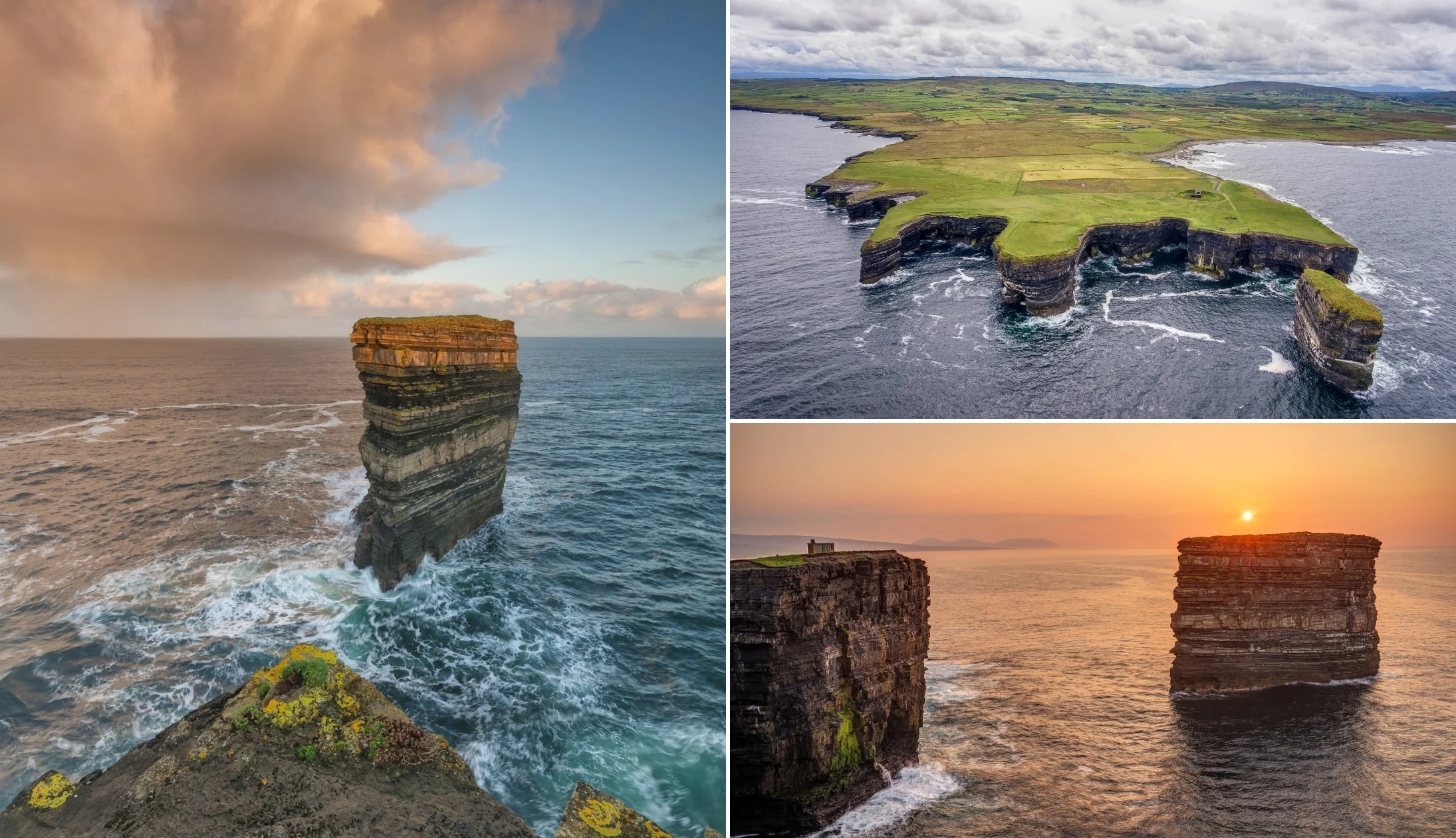
Photos via Shutterstock
Jumping back in the car, we’ll drive 34 minutes to the spectacular Dun Briste sea stack, just off Downpatrick Head. Standing 45 metres high, 63 metres long and 23 metres wide, it lies just 200 metres offshore and is home to puffins, kittiwakes and cormorants. There’s a spacious car park when you reach the headland, and from there, it’s about a 15-minute walk to the edge of the cliffs.
With its colourful rock strata and churning waters below, it’s an impressive sight. Legend tells that it was formed by Saint Patrick, who struck the ground with his crozier to strand Crom Dubh, a Celtic Chieftain. There’s a clatter of things to see at Downpatrick Head, including the WWII EIRE 64 lookout post, St Patrick’s Church, and Pul Na Sean Tinne, a blowhole known as the “Hole of the Old Fire”. You’ll also find a nice tea shop and cafe there.
Stop 3: Ceide Fields

Photo left and bottom right: Michael Mc Laughlin. Top right: Alison Crummy. Via Failte Ireland
Our next stop is the Ceide Fields, just a 19-minute drive from Dun Briste. More than 6,000 years old, this remarkable neolithic site perches atop the cliffs, some 113 metres above the sea. This extensive Stone Age monument is the oldest-known field system in the world, containing a number of megalithic tombs, ancient stone-walled fields, and the remains of centuries-old dwelling places.
There’s a fantastic visitor centre, which rises from the peat bog in a pyramid shape and boasts an array of displays and exhibits to check out. You can enjoy a guided tour of the area too, or visit the viewing platform. And of course, there’s a decent little cafe too.
Stop 4: Ballycroy – Wild Nephin National Park
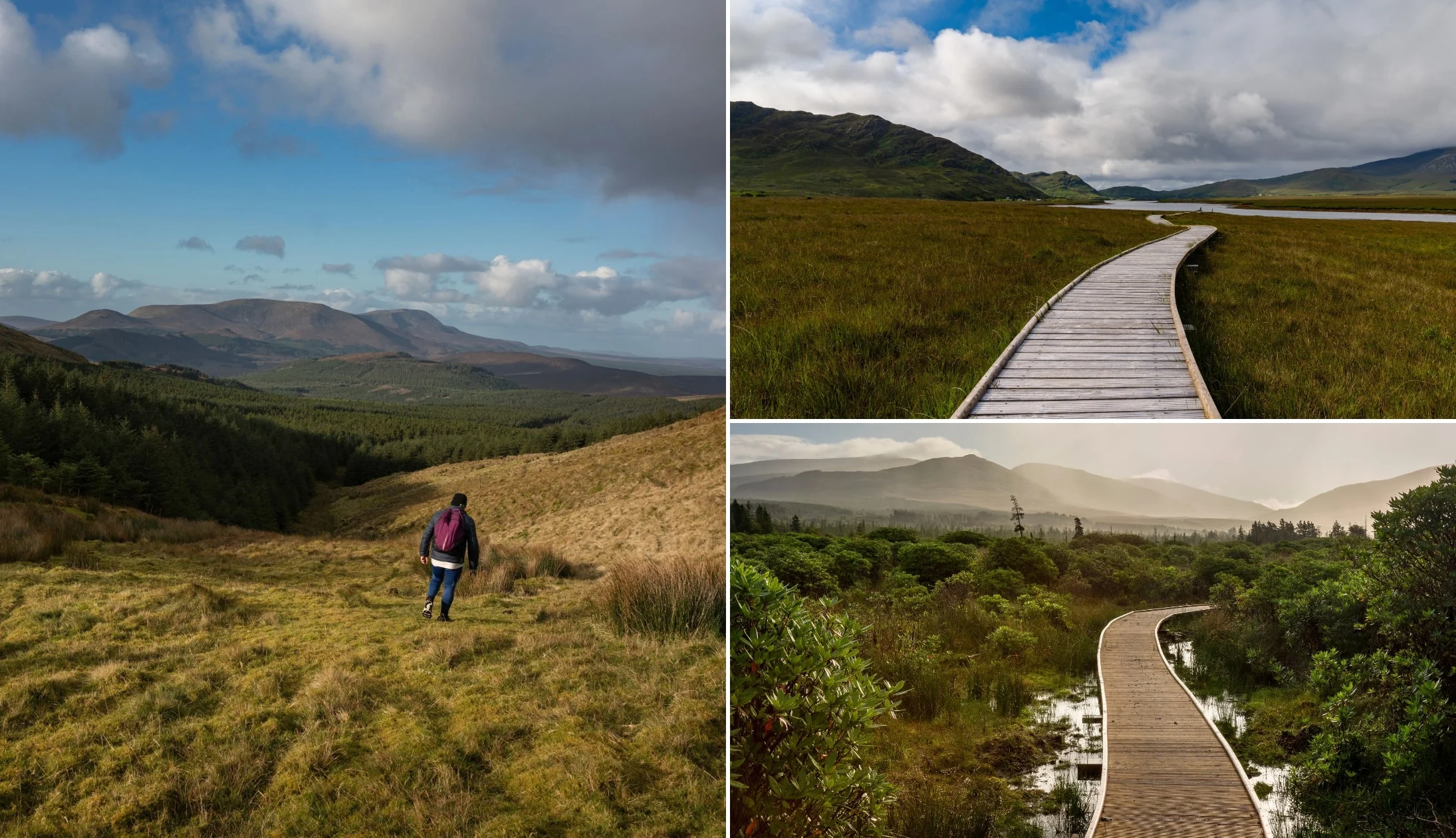
Photos via Shutterstock
After Ceide Fields, we’ll take a beautiful 50-minute drive through the stark beauty of Mayo’s countryside before arriving at Ballycroy Visitor Centre in the heart of Wild Nephin National Park. The park is home to a wealth of gorgeous lakes, mountains, and bogs, with a range of walks to suit all schedules and abilities.
First, it’s worth popping into the visitor centre, which showcases some fascinating displays and exhibits that explain the history and culture of the area. If you want to check out your beautiful surroundings, there’s a nice, easy-going 2 km walk from the visitor centre that offers spectacular views out to Achill Island and the Nephin Beg Mountain Range.
Stop 5: Lunch on Achill Island

Photos via Beehive Crafts and Gifts on FB
For lunch, we’ll drive over the Michael Davitt Bridge onto the epic Achill Island, which boasts breathtaking landscapes and plenty to see and do. For food, the lively village of Keel, about 45 minutes from Ballycroy, is the place to be, with several pubs, cafes, and restaurants to choose from.
We recommend the Beehive Crafts and Gifts Restaurant, with excellent indoor and outdoor seating, and a varied menu, with options for all dietary requirements. Be sure to check out the fishcakes! Alternatively, The Currach is a good choice and they do a mean seafood chowder.
Alternatively, stop off at Blásta at Ted’s in Cashel. Parked up in the pub car park, this fantastic food truck offers up a wealth of tasty treats, including mussels, excellent fish and chips, shrimp tacos, and falafel. With daily specials, there’s always something new to try. In fact, the only problem with Blásta is that it’s so hard to choose just one thing!
Stop 6: Keel Beach
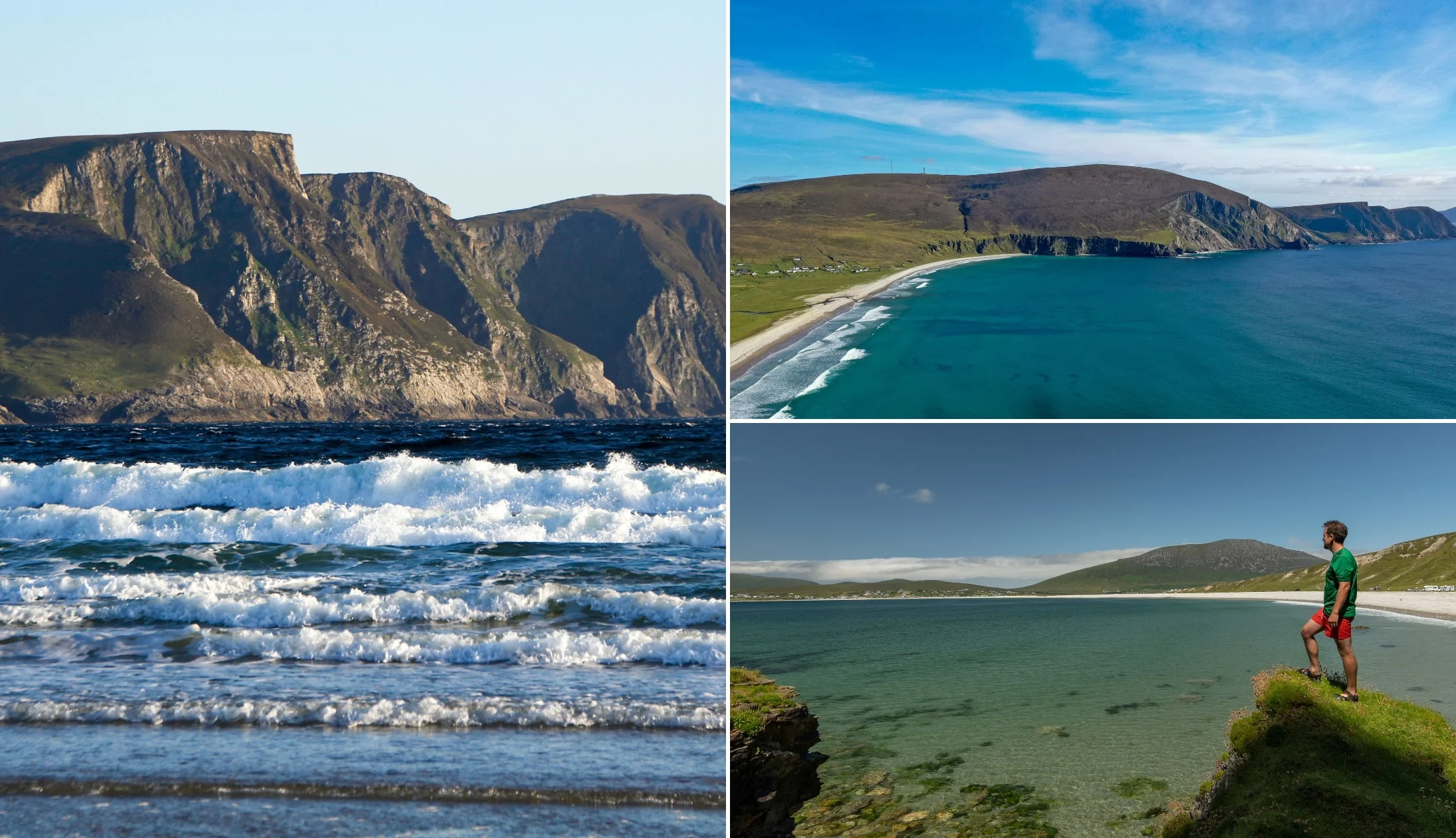
Photos via Shutterstock
After lunch, feel free to potter about Keel Beach, one of the most popular on Achill, especially for surfers. There’s even board and wetsuit rental if you fancy giving surfing a go yourself! Blue Flag certified, the beach enjoys fantastic water quality, as well as a seasonal lifeguard service, making it a great spot for swimming too.
You’ll find plenty of parking at Keel Beach, as well as clean toilets, and numerous picnic tables. It’s a 12-minute drive from Ted’s, or just down the road from the restaurants and cafes in Keel.
Stop 7: Keem Bay

Photos via Shutterstock
Next stop, the exotic-looking Keem Bay. Seriously, on a sunny day, it looks more like Bali than Ireland! Surrounded by towering green cliffs, it boasts a luscious white sandy beach and crystal-clear seas. A nice place for a swim (lifeguards are on duty during summer months), it’s also a top place for relaxing and taking in the scenery. The 12-minute drive up there from Keel is also incredibly scenic, so be sure to take your time.
Stop 8: White Cliffs of Ashleam

Photos via Shutterstock
The White Cliffs of Ashleam are another Achill Island highlight that are well worth driving to. If you put “White Cliffs of Ashleam @ Wild Atlantic Way” into Google Maps, it’ll take you on a 30-minute drive from Keem to the viewpoint, taking in amazing scenery the entire way. The road winds up to the viewpoint, and from there, you’ll get a fantastic eyeful. The jagged, bright white cliffs seem to cut into the sea, which crashes against them in a violent yet beautiful display.
Stop 9: Grace O’Malley Towerhouse

Photos via Shutterstock
Our final stop on Achill Island takes us to Grace O’Malley’s Towerhouse. It’s just an 11-minute drive from the White Cliffs of Ashleam on the edge of Achill Sound. The tower dates back to the 15th century and was famously used by Grace O’Malley, the legendary Pirate Queen, who ruled the island hundreds of years ago. You’ll find a small car park at the tower, and if you want to get close, just hop over the stile and walk over.
Stop 10: Back to Westport for the night
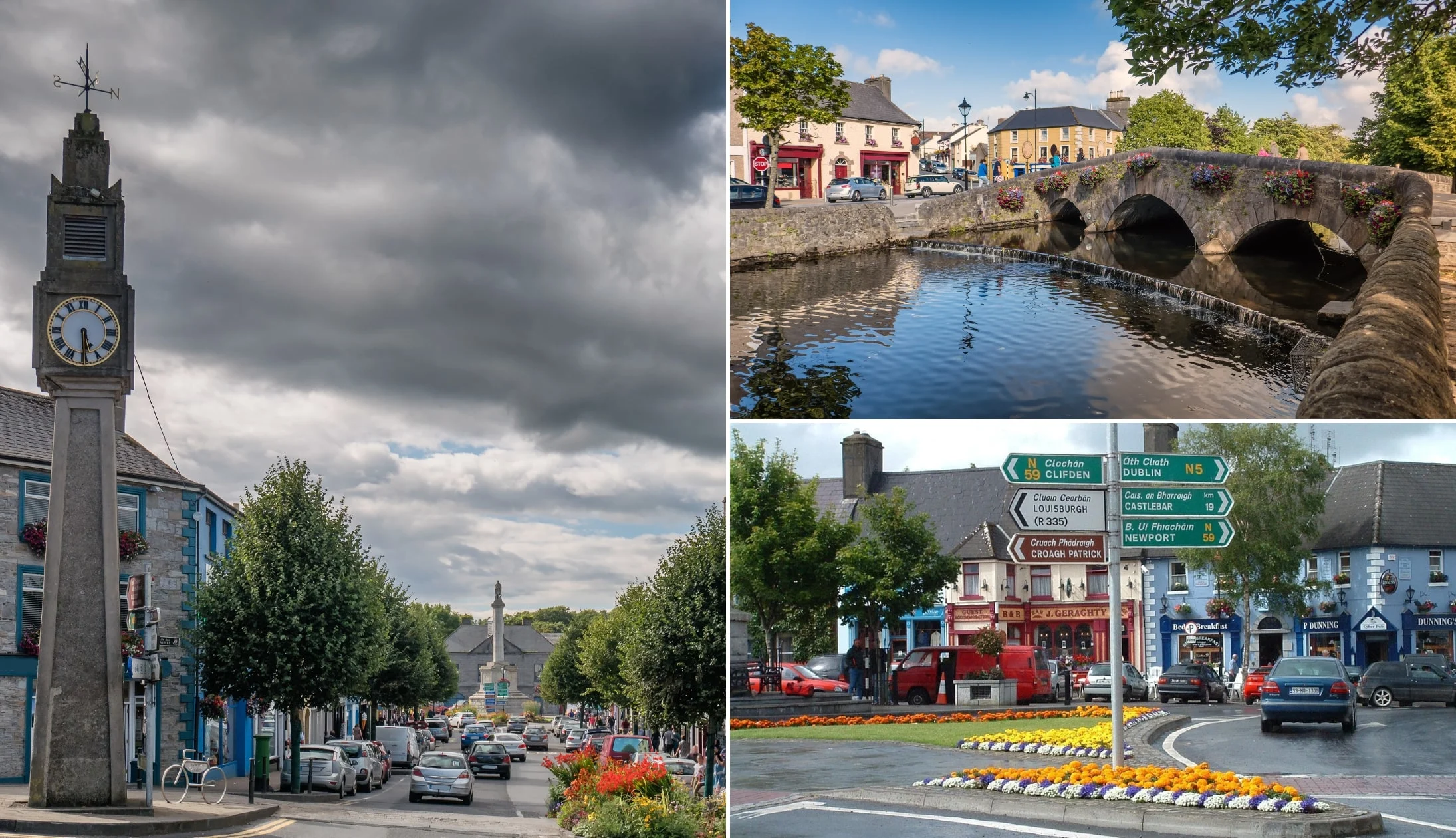
Photos via Shutterstock
Our final stop for the day takes us back onto the mainland and to the vibrant seaside town of Westport, which is about 50 minutes away.
Along the way, we’ll pass Clew Bay, which is home to 365 islands, one for each day of the year. After a long day on the road, you’ll want to check into your accommodation, freshen up, and then reward yourself with dinner and a few drinks in town.
Our Westport food recommendations
There’s some excellent restaurants in Westport and the town is another great place for locally-sourced food, with a host of restaurants to choose from. The award-winning An Port Mor, located in the town centre, is one of the best, with an array of succulent dishes, including the ever-popular Clew Bay Lobster.
JJ O’Malleys is another great choice, beloved by locals and visitors alike for its extensive menu that combines traditional Irish food and seafood with contemporary dishes. Plus, the decor is fantastic!
Our Westport pub recommendations
There’s some mighty pubs in Westport, too! For an end-of-day pint, you’d struggle to beat a visit to Toby’s Bar.
Small and unassuming, it’s a favourite among locals, with a friendly crowd of regulars. It boasts a fantastic atmosphere and many say that they pour the best pint of Guinness in town.
Blousers is another great option, especially on a cold night. A dram of whiskey or a pint by the roaring fireplace is always a welcome treat, plus they’ll often have live music.
The most iconic pub for live music in Westport is definitely Matt Molloy’s. It’s owned by the flautist from The Chieftains (if you’ve not heard them, check them out!) and offers traditional Irish music live every night. It has a lively atmosphere and often attracts a crowd.
Day 4: Westport and surrounds
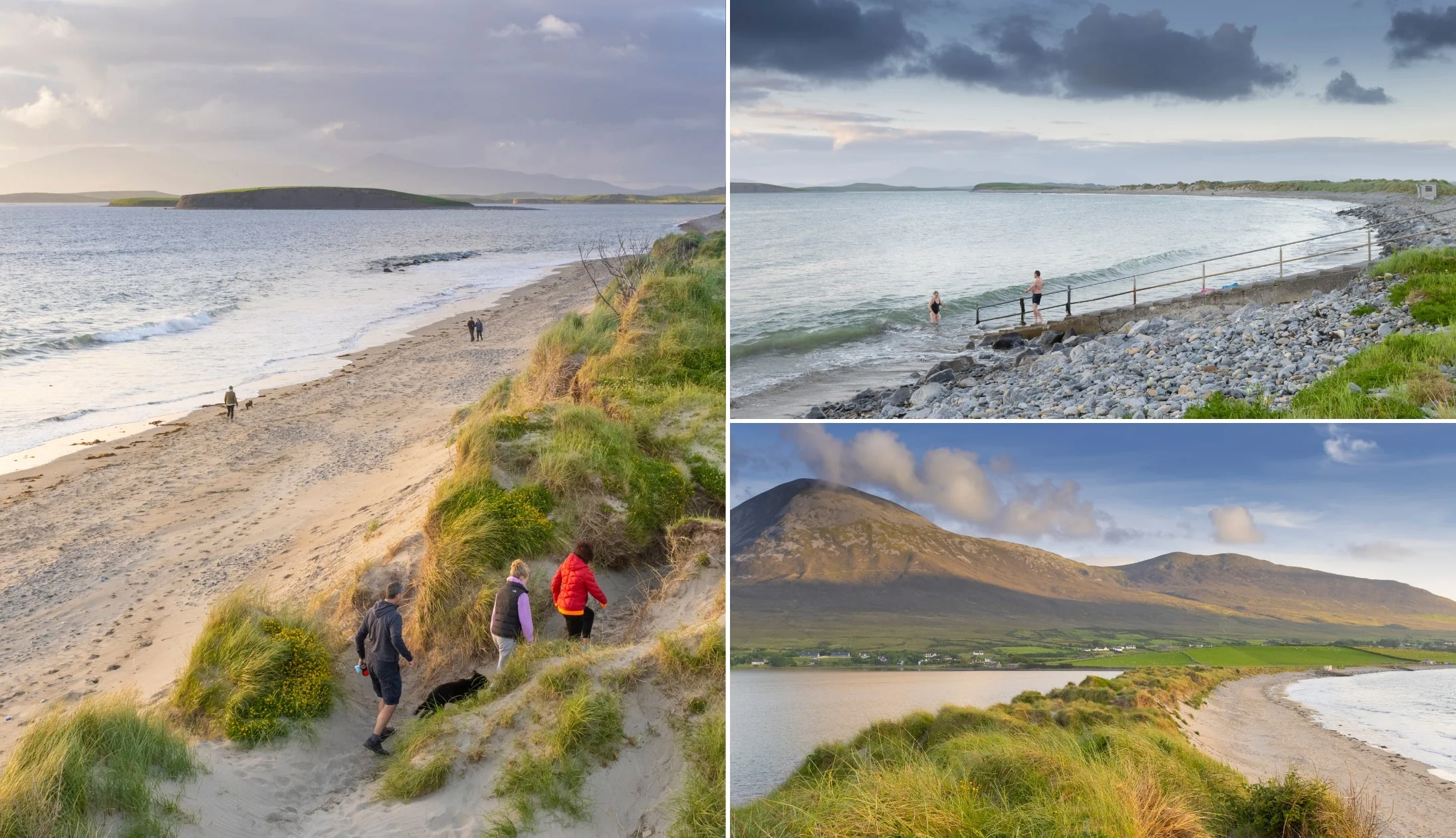
Photos courtesy Michael Mc Laughlin via Falte Ireland
After a day of exploring the coasts and countryside of County Mayo, we’ll be taking it easy today as we discover the attractions in and around Westport. From beaches to historic houses, there’s lots to take in, all at your own pace.
First things first, you’ll want to grab a hearty breakfast either at your accommodation or in town. If you’re heading into town, This Must Be The Place serves up a mighty feed and a superb cup of coffee. The menu encompasses a bunch of healthy breakfast classics, as well as vegan options, toasties, and tasty cakes.
If you’re craving something not quite so healthy, get down to Cian’s for one of the best full Irish breakfasts in the country. The locally sourced ingredients make all the difference and it makes for a decadent start to the day.
Stop 1: Westport House
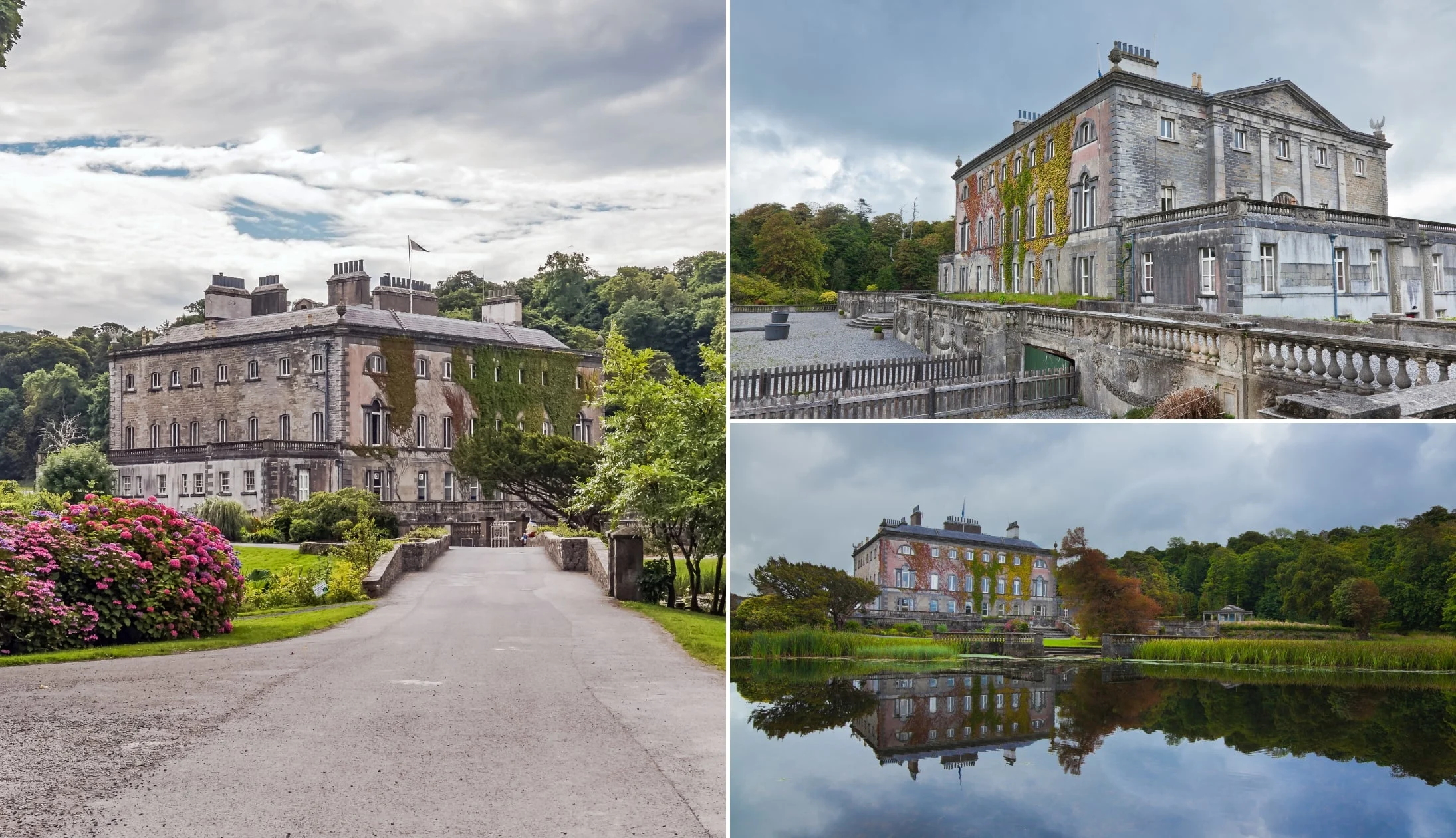
Photos via Shutterstock
Our first stop of the day is the stunning Westport House. You can also walk there from the town centre in around 15 minutes. There are loads of things to see and do at this spectacular country estate.
The grounds and gardens cover more than 400 acres, and a number of walking trails enable you to explore terraces, forests, and flower gardens.
Stepping inside takes you back in time, and you can enjoy either a guided or self-guided tour of the property. As you go, you’ll discover the history of the house and its various rooms through stories, artwork, and exhibits.
Stop 2: The National Famine Memorial
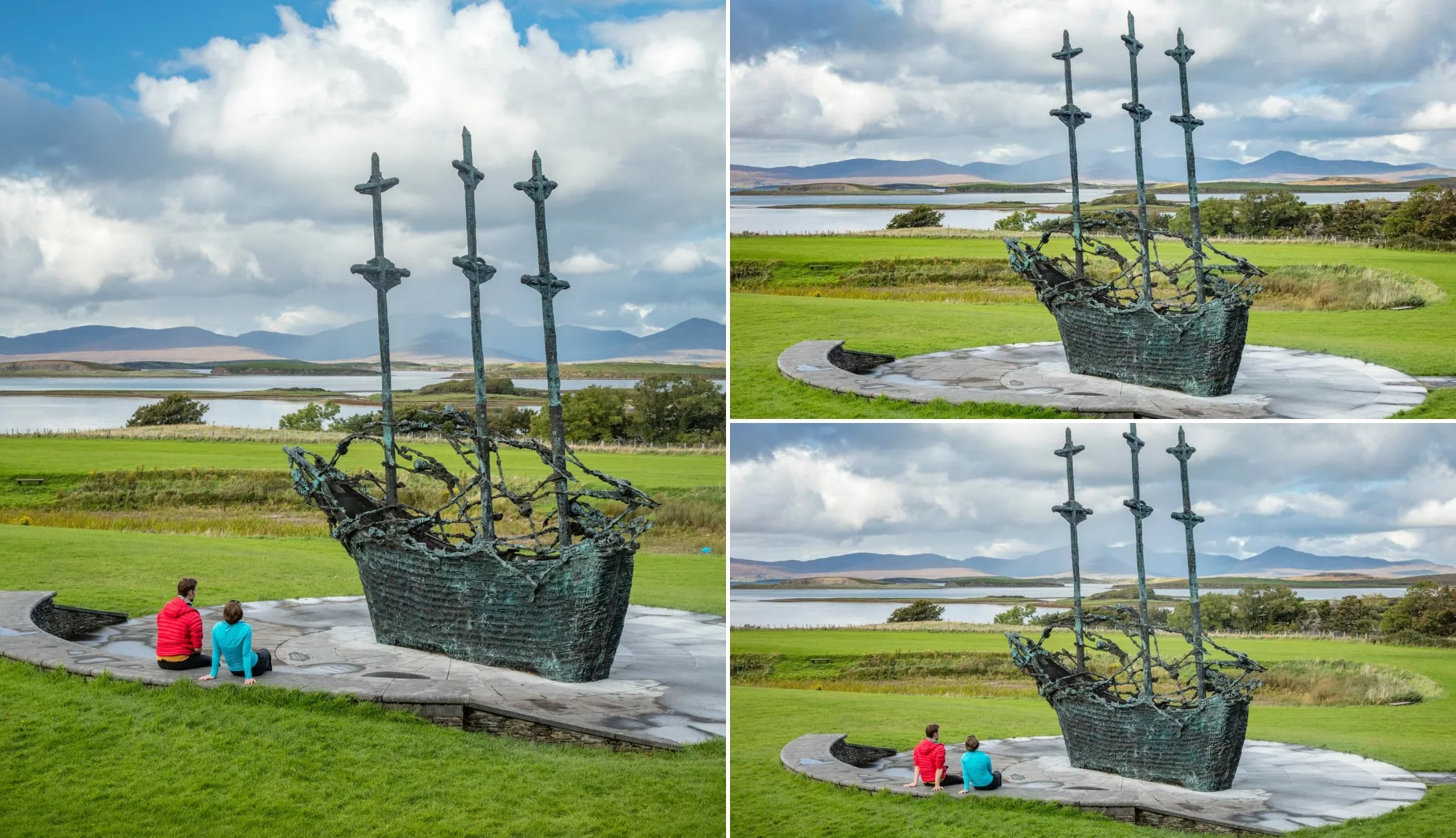
Photos courtesy Gareth McCormack/garethmccormack via Failte Ireland
The National Famine Memorial is about a 20-minute drive away from Westport House, in the vibrant village of Murrisk.
Sitting in the shadow of Croagh Patrick, you’ll be rewarded with more excellent views of the holy mountain.
The area marks the start point of the annual pilgrimage up the mountain, while the memorial stands as a poignant monument to everyone who died or immigrated during the famine.
Stop 3: Murrisk Abbey

Photos via Shutterstock
Just a 3-minute walk from the National Famine Memorial, Murrisk Abbey is a gorgeously peaceful place to wander around.
The ruins date back to 1456 yet remain remarkably well-preserved in spite of their age. A number of information panels provide further details of the history of the area, which now also serves as a cemetery.
Stop 4: Bertra Beach

Photos courtesy Michael Mc Laughlin via Falte Ireland
There’s a handful of beaches near Westport, but few can go toe-to-toe with the brilliant Bertra Beach.
It’s a handy 5-minute spin from the abbey and, despite being a favourite amongst locals, many tourists tend to miss it.
It’s a lovely spot for an early morning saunter and it’s nice and close to your next stops today.
Stop 5: Lunch in Westport
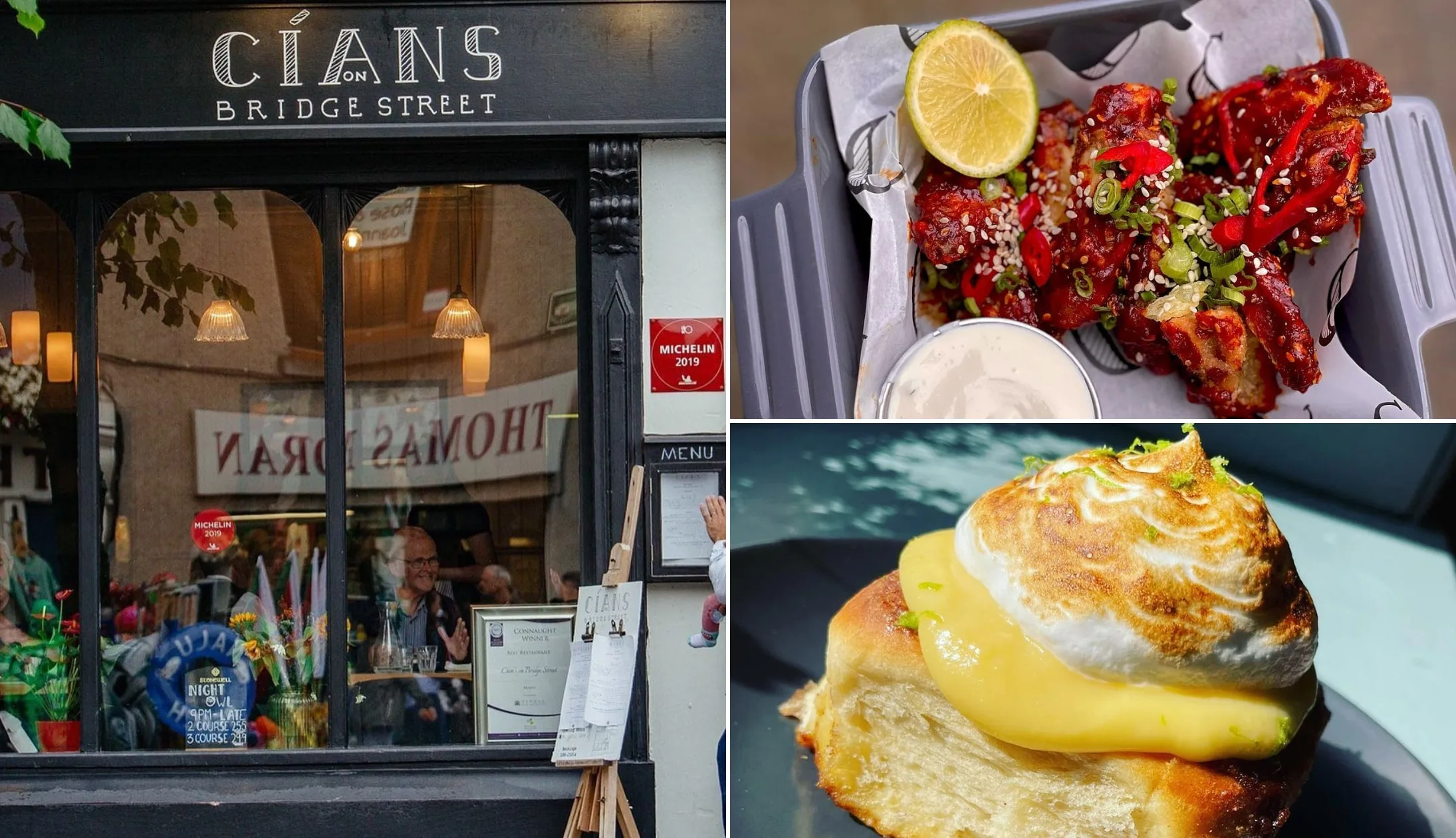
Photos via Cian’s on FB
Head back to Westport for lunch, where you’ll find a host of great places to grab a bite to eat. Check out Cian’s on Bridge Street if you haven’t already for an array of sensational Irish dishes, like the incredible roast lamb rump. Or, for vegan dishes and lighter bites, get down to Friend’s Bistro. You should find plenty of street parking near both cafes, particularly around the Octagon.
Stop 6: Tourmakeady Woods
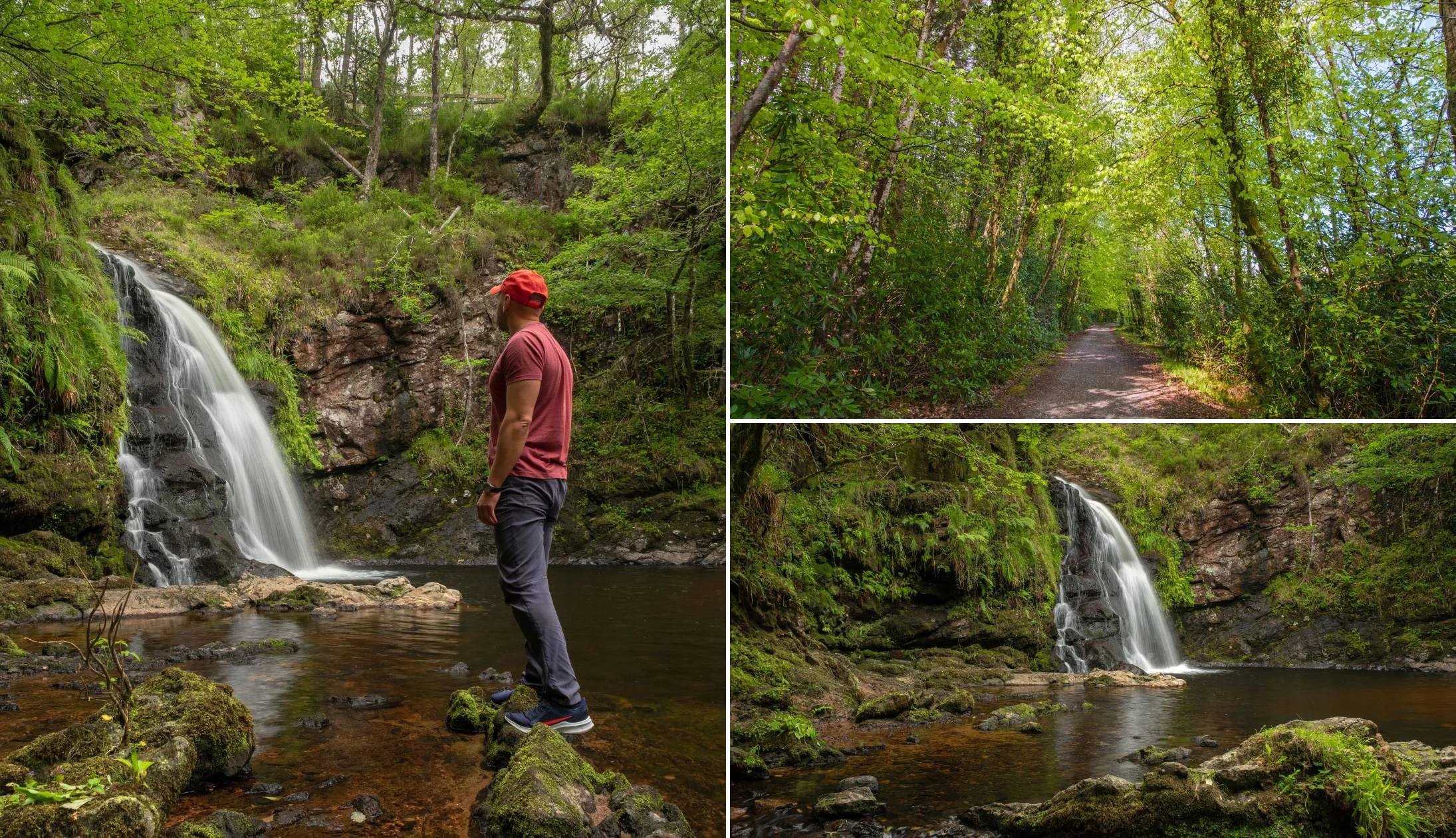
Photos via Shutterstock
You’ll find Tourmakeady Woods around a 30-minute drive from Westport. There’s a lovely 30-minute ramble here that takes you through lush forest and on to see Tourmakeady Waterfall.
This is one of Mayo’s hidden gems and it’s a nice escape from the hustle and bustle of Westport Town.
Stop 7: Dinner, drinks and live music

Photos via The Old Grainstore on FB
It’s been a busy day, so why not grab dinner and finish your night with a pint at the iconic Matt Molloy’s Pub for some of the best live trad sessions this side of the Shannon?
Our Westport food recommendations
There’s some excellent restaurants in Westport and the town is another great place for locally-sourced food, with a host of restaurants to choose from. The award-winning An Port Mor, located in the town centre, is one of the best, with an array of succulent dishes, including the ever-popular Clew Bay Lobster.
JJ O’Malleys is another great choice, beloved by locals and visitors alike for its extensive menu that combines traditional Irish food and seafood with contemporary dishes. Plus, the decor is fantastic!
Our Westport pub recommendations
There’s some mighty pubs in Westport, too! For an end-of-day pint, you’d struggle to beat a visit to Toby’s Bar.
Small and unassuming, it’s a favourite among locals, with a friendly crowd of regulars. It boasts a fantastic atmosphere and many say that they pour the best pint of Guinness in town.
Blousers is another great option, especially on a cold night. A dram of whiskey or a pint by the roaring fireplace is always a welcome treat, plus they’ll often have live music.
The most iconic pub for live music in Westport is definitely Matt Molloy’s. It’s owned by the flautist from The Chieftains (if you’ve not heard them, check them out!) and offers traditional Irish music live every night. It has a lively atmosphere and often attracts a crowd.
Day 5: Connemara

Photos via Shutterstock
Today you’re heading down through Connemara (an incredibly scenic part of the country) to Galway City, where you’ll be spending two nights.
You’ve got a busy day ahead, so enjoy a hearty breakfast at your accommodation, or, if you’d prefer to have breakfast out, Christy’s Harvest and This Must Be The Place are both solid choices.
Recommended accommodation in Galway
- Budget: Feeney’s Audubon Lodge (in Salthill outside of the city by the sea) and Corrib View Guesthouse (a 45-minute walk from Eyre Square)
- Mid-range: Balcony House B&B (10-minute walk from Eyre Square) and Ash Grove House (gorgeous guesthouse near Galway Cathedral)
- Luxury: The G Hotel (luxury hotel in the city) and Glenlo Abbey (one of Ireland’s top hotels – 15-minute drive from the city)
Stop 1: Silver Strand in Louisburg

Photo left and top right: Kelvin Gillmor. Other: Google Maps
Today’s drive is all about taking in some of Ireland’s most stunning landscapes. This first leg takes us on a short but sweet 25-minute drive from Westport to the charming village of Louisburg.
The road hugs the southern edge of Clew Bay, with the sea and its many islands on one side, and the mighty Croagh Patrick mountain on the other.
Once you arrive in Louisburg, feel free to park up, stretch your legs, and grab a cup of coffee. Tia Cafe does a great cup, plus tasty cakes and bakes, and you can normally park right out in front on the roadside.
When you’re ready, take the short drive around to Silver Strand Beach. This is one of the Wild Atlantic Way’s finest, so soak up the sights, sounds and fresh sea air for a bit.
Stop 2: The Doolough Valley
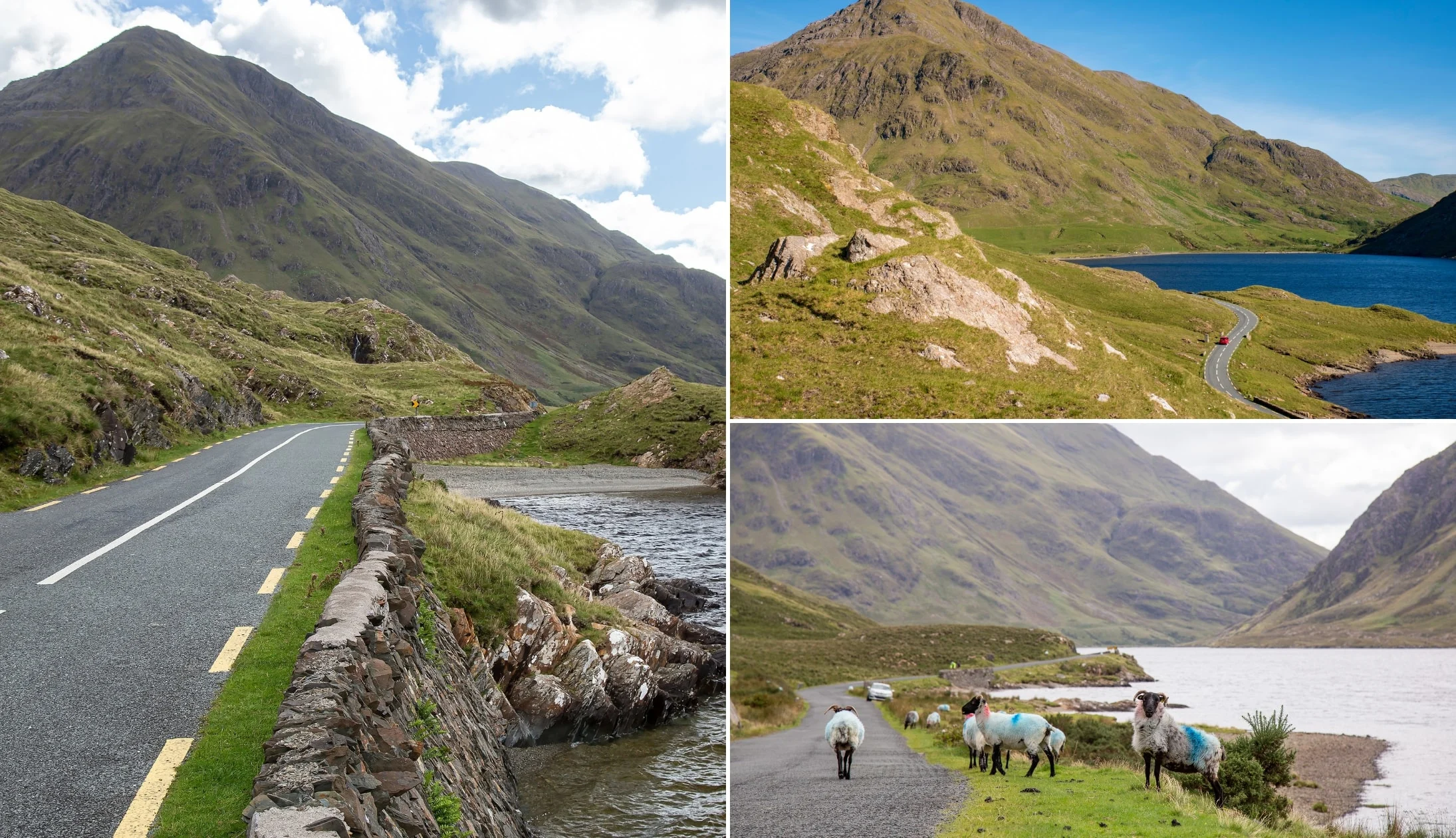
Photos via Shutterstock
After you leave Louisburgh, you’ll be making your way to Leenane via the outstanding Doolough Valley.
This stretch of road is one of the most scenic drives in Ireland, and you’ll often find the place virtually empty.
Before you enter the valley, you’ll reach a Wild Atlantic Way viewpoint sign. Stop here, and you’ll have a view of the area in the photo above.
When you’re ready, follow the road as it winds around the ink-black waters of the Killary Fjord towards the village of Leenane.
Stop 3: Aasleagh Falls

Photos via Shutterstock
Take your time on the 35-minute drive through Doolough and you’ll eventually reach Aasleagh Falls, which lies at the head of Killary Fjord.
There are two car parks at the falls, and it’s just a short walk to the cascade. However, with no official path to the waterfall, be prepared to cross a mucky field. It’s a gorgeous cascade, especially after the rain, and it’s a fine place to relax a little while, contemplating the meaning of life as the tranquil sound of running water fills the air.
Stop 4: Leenane and Killary Fjord
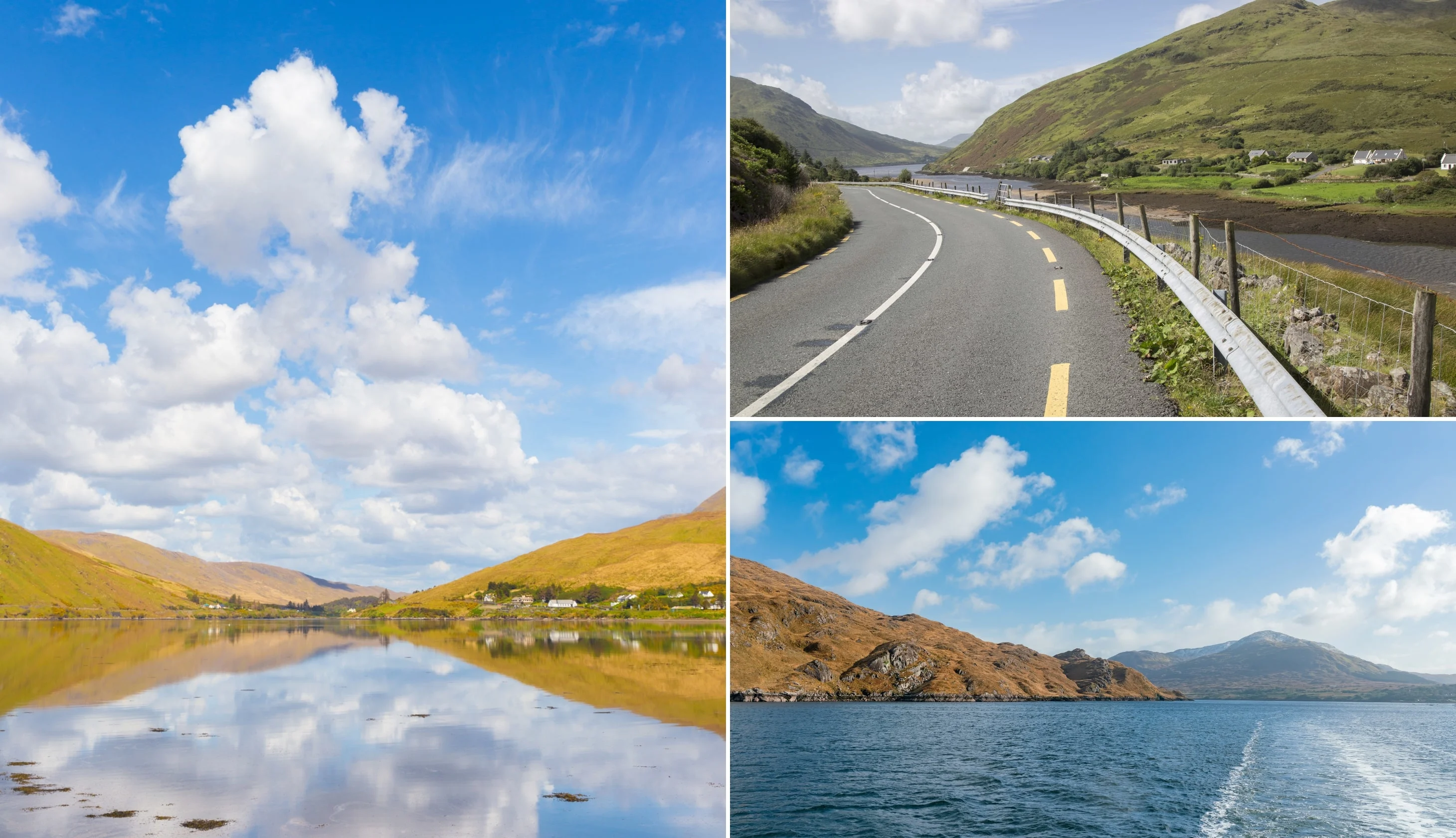
Photos via Shutterstock
The gorgeous village of Leenane is just a short 5-minute drive from the waterfall. It sits on the edge of Killary Fjord, the only fjord in Ireland, and it’s another area of spectacular scenery. The village offers a truly authentic experience of rural Ireland, and for most of the year, it’s pretty quiet, although it can get busy in summer.
Having said that, there are plenty of attractions. It’s perhaps most well-known for serving as the impressive backdrop to Jim Sheridan’s classic, ‘The Field’, starring Richard Harris, John Hurt, Sean Bean, Brenda Fricker, and Tom Berenger. Fans of the movie will recognise much of the village, especially Gaynor’s Bar, which starred as the local pub in the film.
The Sheep and Wool Centre is always worth checking out, and you can find hand-crafted woolly sweaters, scarves, and much more while learning about how they’re made.
Stop 5: Kylemore Abbey

Photos via Shutterstock
Our next stop is the epic Kylemore Abbey. Built in 1867, it’s perched on the edge of both Pollacapall Lough and the breathtaking Connemara National Park. As you wander the grounds, enjoy the gardens, church, and abbey, before checking out the tea room and gift shop.
The grounds cover a staggering 13,000 acres of land and include magnificent gardens, walks and woodlands. Meanwhile, inside the tour takes visitors on a journey through the many generations of people who have dwelled, worked, studied and prayed inside the castle’s magnificent walls.
Visitors will have stories brought to life in spectacular fashion via historical photographs, audio-visual presentations, artefacts, historical costumes and much more.
Stop 6: Lunch in Letterfrack

Photos via Veldons on FB
Just 7 minutes down the road from Kylemore Abbey, the bustling village of Letterfrack is a great choice for lunch. You’ve got some fantastic options too. One of our favourites is the Clover Fox Restaurant and Bar. This traditional pub boasts open fires and a welcoming atmosphere, as well as a varied menu that takes in fresh, local seafood and a wealth of classic Irish dishes.
For more sumptuous seafood, Veldons Seafarer Bar and Restaurant is an excellent choice, and their seafood platter is hard to beat. For a lighter lunch of sandwiches, toasties, quiche, cakes, and coffee, the Hungry Hiker is a must. You can sometimes find street parking in Letterfrack. Otherwise, park up at the Connemara National Park Visitor Centre.
Stop 7: The Sky Road
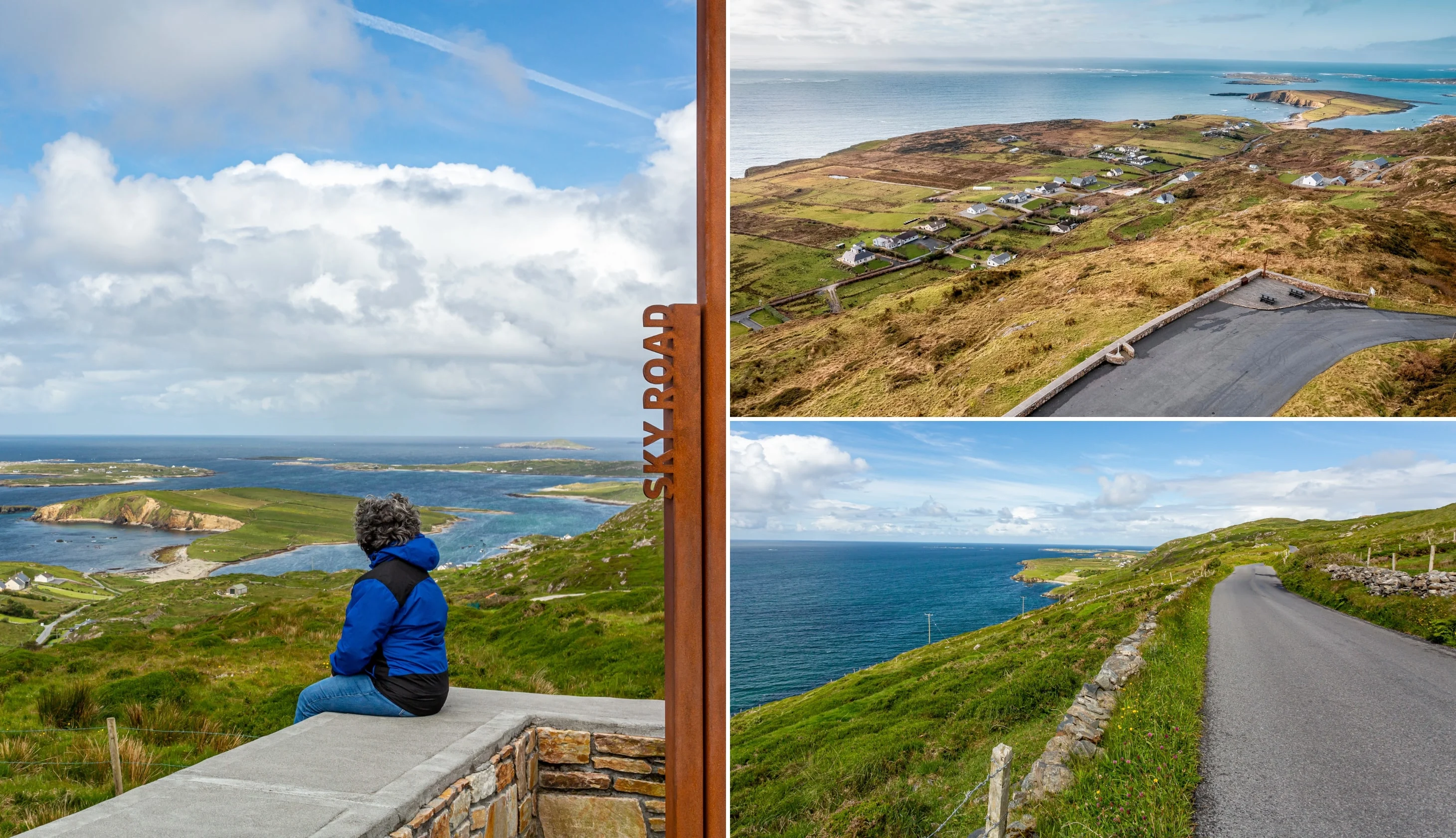
Photos via Shutterstock
Head 18 minutes south to Clifden and then follow signs for the Sky Road.
The Sky Road is a breathtaking 16km loop. It begins in Clifden, making its way around the Kingston peninsula along a coastal road with stunning views. Along the way, the loop passes by Clifden Castle, a ruined manor house overlooking the water.
After the castle, the Sky Road deviates into two routes which join up again later, the lower road which has close-up views of the sea, and the upper road, which has views over the bay.
Some scenic stops along the way are Clifden Castle, the viewing point on the upper road, and Eyrephort Beach. We’d say two hours is a good length to spend on the Sky Road including stops, but this depends on what time you begin the drive.
Stop 8: Dinner, drinks and live music in Galway
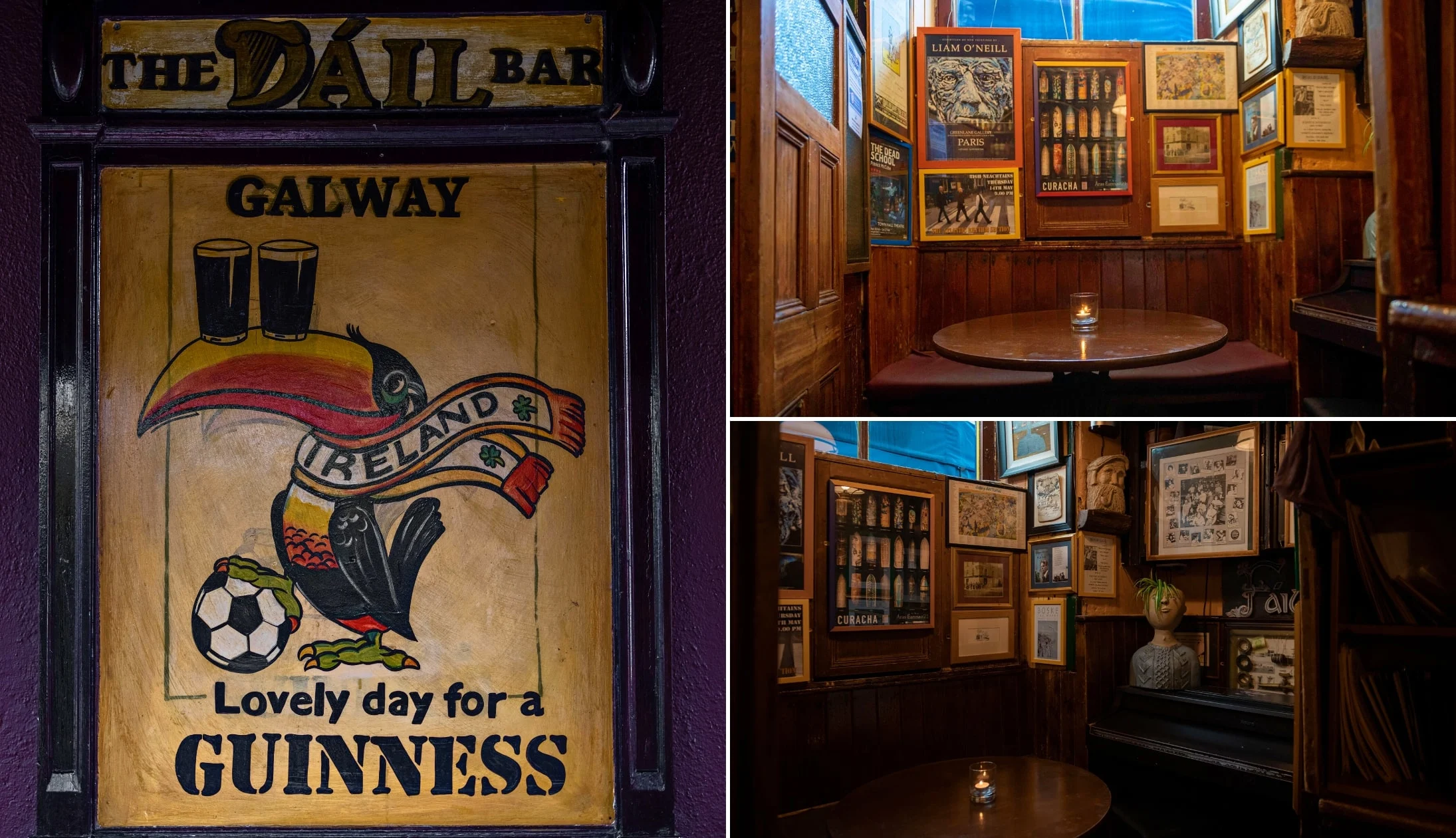
Photos courtesy Failte Ireland
Once you’ve finished the Sky Road loop, it’s time to head south to Galway, a roughly one hour and 20-minute drive. Check into your accommodation then head out for a night of food and music.
Galway is a lively city regardless of the time of year. Here’s some spots worth checking out:
Our dinner recommendations
There’s some excellent restaurants in Galway – our favourites are Ard Bia, The Quay Street Kitchen, and Dela. Ard Bia is absolutely fantastic, but you need to book in advance for dinner.
The restaurant has a quirky interior and serves beautifully presented modern dishes.
The Quay Street Kitchen has a great selection of vegan and vegetarian-friendly dishes, and Dela has modern Irish cuisine on the menu.
Live music and trad bars
There’s some mighty pubs in Galway. After dinner, head out for drinks at either Tigh Neachtain or The Crane. Both are traditional pubs with a great atmosphere.
Trad music is an integral part of the city, with heaps of options to choose from. Our favourite spots are Crane Bar (mentioned above) and Tigh Chóilí.
Day 6: Galway City

Photos by Stephen Power via Ireland’s Content Pool
Today, you’ve got the whole day to explore Galway and its wonderful attractions.
We’re going to recommend that you start your day out in Salthill, by the sea, before coming back into the city and either exploring on foot or via a hop-on/hop-off bus tour.
Stop 1: Breakfast in Salthill

Photos via Shutterstock
We’d recommend driving over to Salthill (5-minute spin) and start the day off with breakfast at Coco Cafe Salthill or Gourmet Food Parlour Salthill.
Then, enjoy a walk along the famous Salthill Promenade (and kick the wall) before heading back towards the city centre.
Stop 2: Decide how you’ll get around for the day
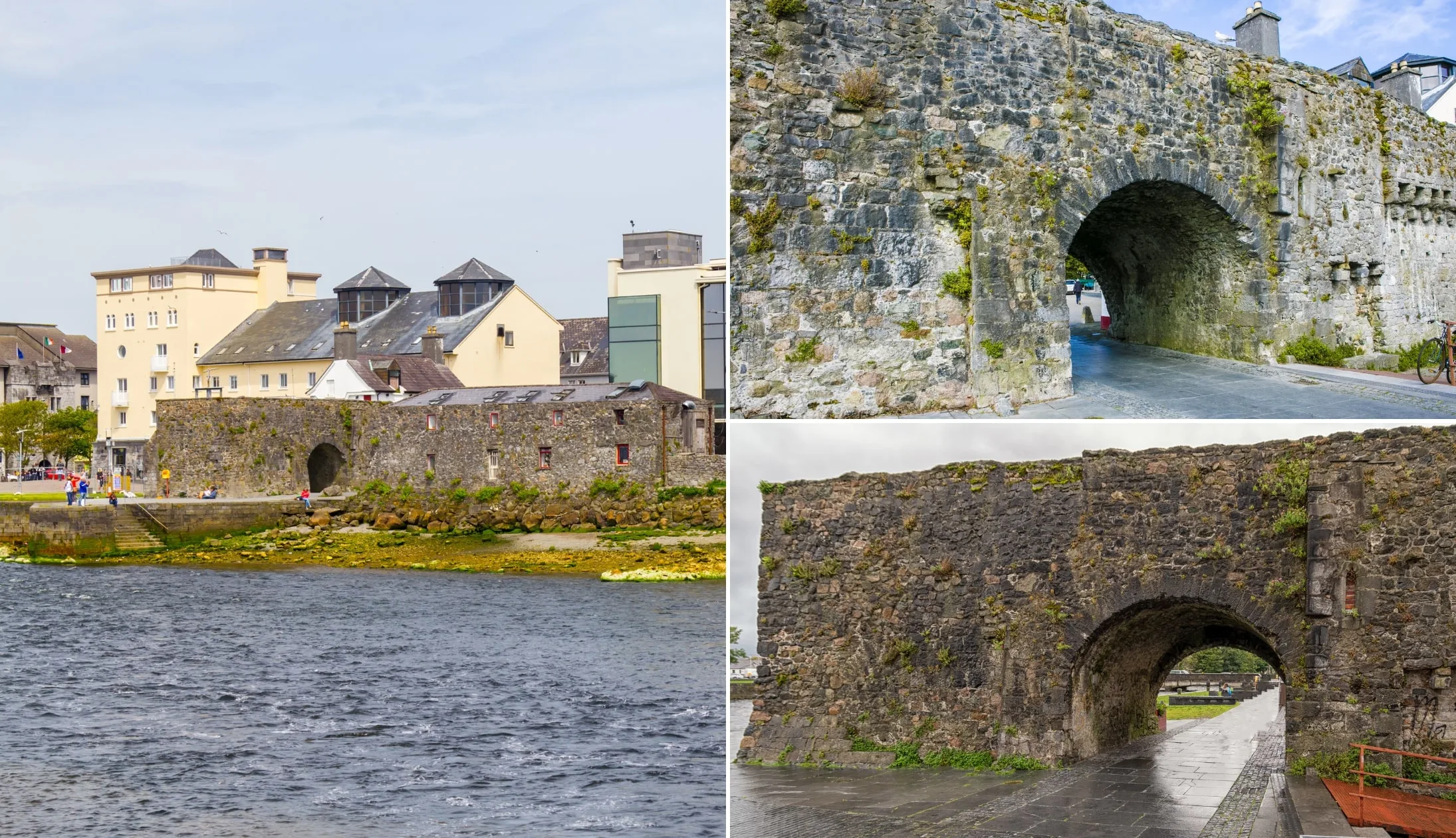
Photos via Shutterstock
Now, Galway is a very walkable city, but if it’s raining or if you fancy getting dropped to the ‘main’ attractions, the hop-on/hop-off bus tour is well worth buying.
Regardless of which option you choose, here are some of our favourite sites in Galway City (we’ve listed them in a logical way for you to walk between them).
Stop 3: Galway Cathedral

Photos via Shutterstock
Galway Cathedral is wonderfully impressive both inside and out. It’s arguably the jewel in the Galway City skyline and you’ll cop it from many places as you stroll around the city.
Interestingly enough, it’s not as old as it looks, and construction on the building was only completed in 1965, earning it the title of ‘the last great stone cathedral to be constructed in Europe’.
The cathedral is free to enter, but visitors are asked for a donation of €2 to help with the building’s upkeep.
Stop 4: Quay Street and the Latin Quarter

Photos by Stephen Power via Ireland’s Content Pool
Galway’s colourful streets are an absolute joy the ramble along regardless of the time of year.
If you’re walking from the cathedral, you’re a short stroll away from the Latin Quarter and Quay Street where you can have a nosey around.
These streets are alive with the buzz from tourists and locals alike.
Stop 5: The Hall of the Red Earl
One of our favourite places to visit in Galway (especially if it’s raining!) is the Hall of the Red Earl.
The Hall of the Red Earl is one of Galway’s most interesting sites. The ruins date back to the 13th century, with ties to the founding of Galway and the Anglo-Norman De Burgo family.
It was the first municipal building in the city, used for collecting taxes, hosting banquets, and sentencing criminals.
The Hall of the Red Earl was lost as the city grew until 1997, when the ruins were unearthed by archaeologists on behalf of the Office of the Public Works.
Today, you can walk amongst the ruins, view the artefacts, and learn about the hall’s history from the informative displays.
Stop 6: Galway City Museum
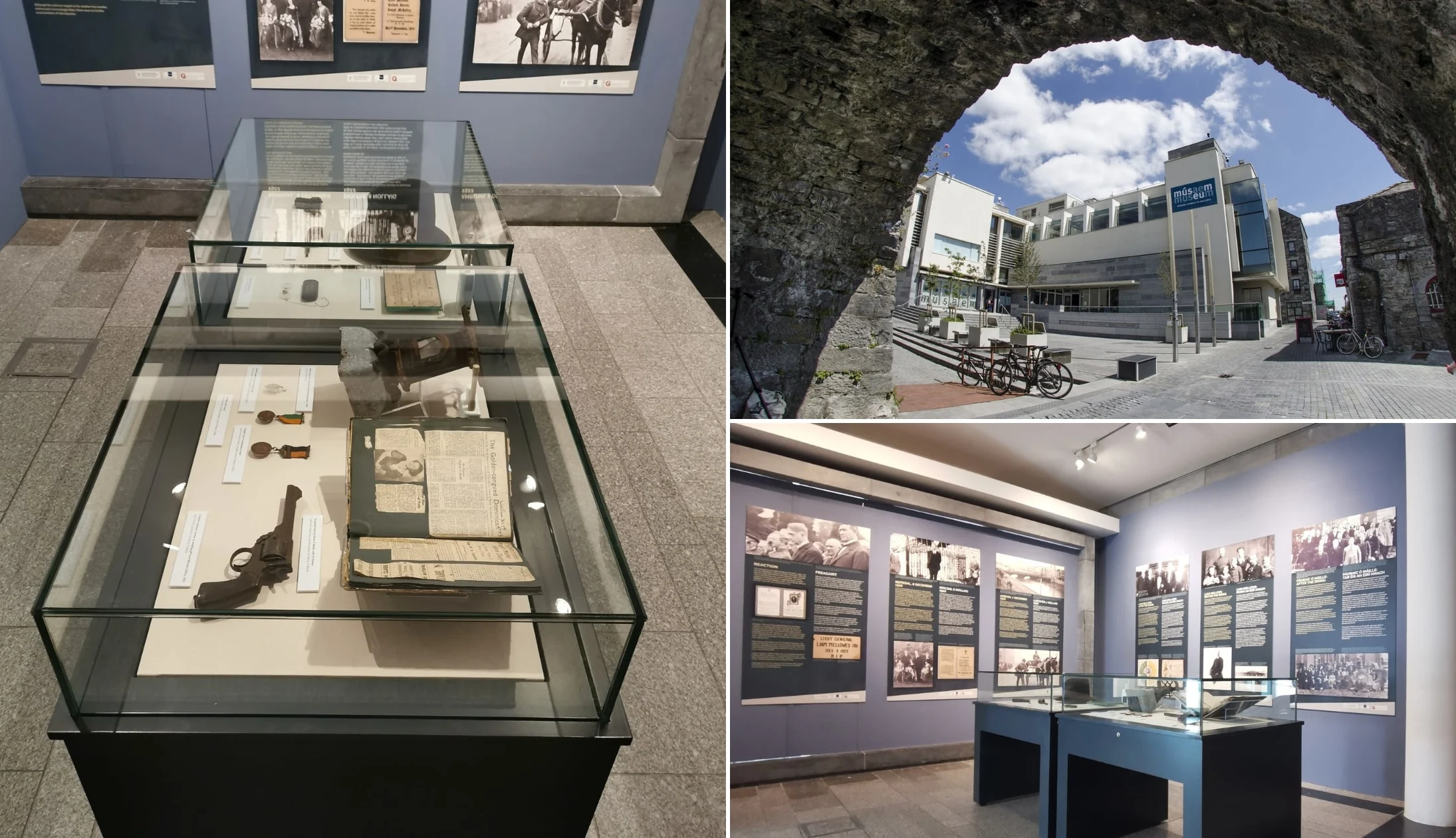
Photos via Galway City Museum on FB
The Galway City Museum is just a stone’s throw from the Spanish Arch. It’s one of the best places to learn about Galway’s history, culture, and archaeology, with collections telling the story of prehistoric Galway all the way through to 19th and 20th-century Galway!
The museum has three floors and seven long-term exhibitions, including The Wild Atlantic – Sea Science, and an exhibition on Pádraic Ó Conaire.
It’s free to visit, although donations are always appreciated.
Stop 7: Spanish Arch and the Long Walk

Photos via Shutterstock
The Spanish Arch is a must-see Galway attraction, dating back to Medieval times. The large stone arch is located on the outskirts of the city centre, overlooking the Claddagh (shore).
It originally housed soldiers who were keeping watch on the city’s Medieval walls. Its nickname is thought to come from the city’s merchant trade with the Spanish, whose ships would often be docked in the area!
From the Spanish Arch, you can take a short stroll alongside the water to what’s known as The Long Walk. You’ll likely have seen pictures of it (it’s a line of colourful buildings right on the water).
Stop 8: Dinner, drinks and live music

Photos courtesy Failte Ireland
Galway is a lively city regardless of the time of year. Here’s some spots worth checking out:
Our dinner recommendations
There’s some excellent restaurants in Galway – our favourites are Ard Bia, The Quay Street Kitchen, and Dela. Ard Bia is absolutely fantastic, but you need to book in advance for dinner.
The restaurant has a quirky interior and serves beautifully presented modern dishes.
The Quay Street Kitchen has a great selection of vegan and vegetarian-friendly dishes, and Dela has modern Irish cuisine on the menu.
Live music and trad bars
There’s some mighty pubs in Galway. After dinner, head out for drinks at either Tigh Neachtain or The Crane. Both are traditional pubs with a great atmosphere.
Trad music is an integral part of the city, with heaps of options to choose from. Our favourite spots are Crane Bar (mentioned above) and Tigh Chóilí.
Day 7: The best of Clare

Photos via Shutterstock
You are heading from Galway to Doolin today, where you will spend two nights. The total drive time is less than two hours, depending on whether you take the coast road. But we have lots of places for you to stop on the way!
Doolin is a lovely village on Ireland’s west coast, known for its trad music. It’s got some lovely places to stay, and we’ve popped out top picks below:
Doolin accommodation recommendations
- Popular and central stays: West Haven House (short stroll from McDermott’s Pub) and Cullinan’s Guesthouse (great reviews and right across from Fitzpatrick’s Bar)
- Our favourites: Doolin Inn (a stone’s throw from Fisher Street), Fiddle + Bow Hotel (boutique and very central) and Hotel Doolin (good value and nice and central)
Stop 1: Dunguaire Castle
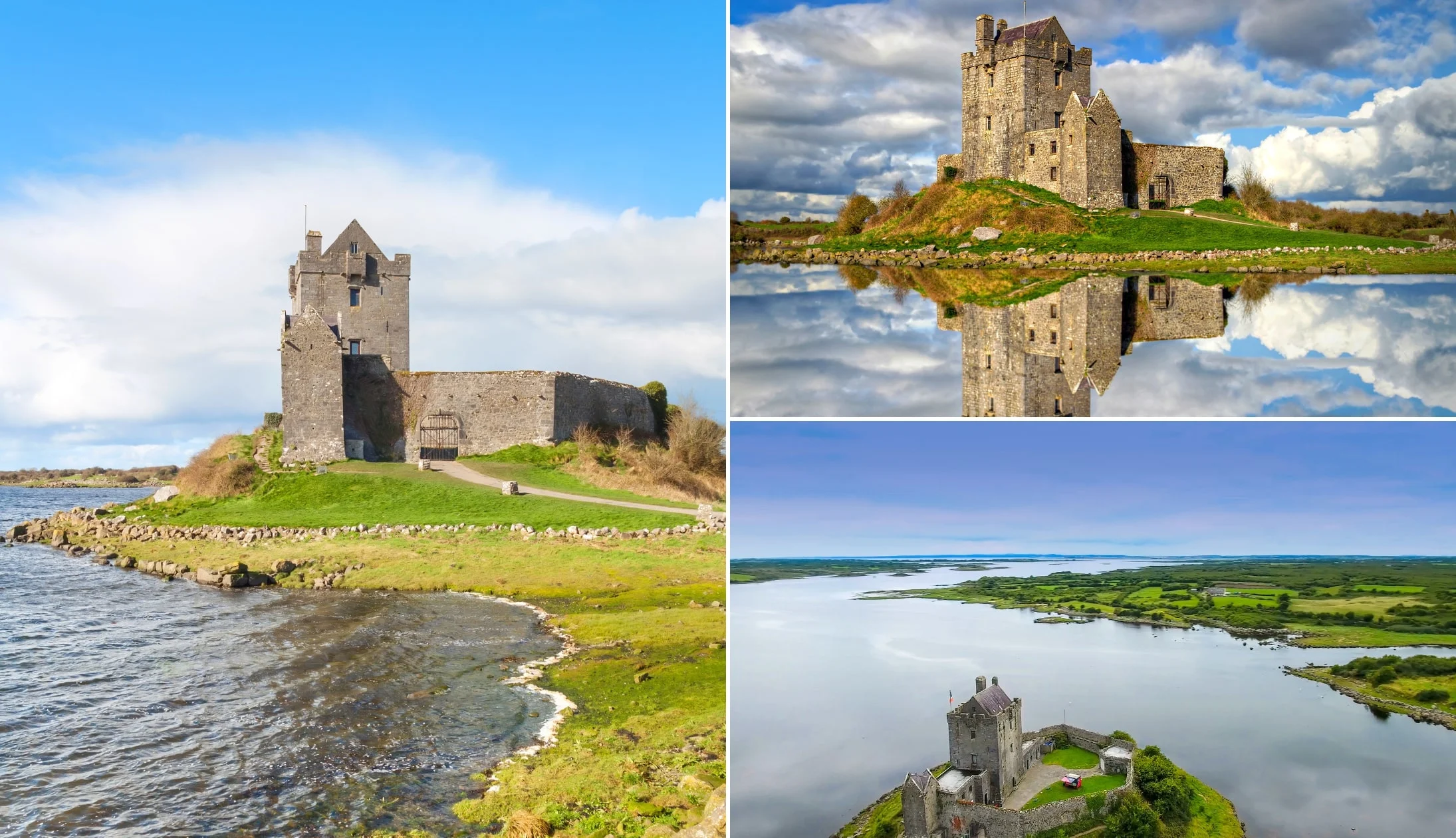
Photos via Shutterstock
Dunguaire Castle is a 35-minute drive from Galway. The castle was built in 1520 and belonged to the O’Hynes clan. In 1912, the castle was bought by writer Oliver St. John Gogarty. During his ownership, he restored the castle and hosted several famous writers, including W.B. Yeats and George Bernard Shaw.
The enchanting castle sits on the shores of Galway Bay and has an impressive 75-foot tower. We’d recommend spending at least an hour here, walking the grounds and taking a self-guided tour. According to legend, if you stand at the front gate and ask a question, you’ll have an answer by the end of the day!
Admission costs €7.50 (adult), €5.5 (seniors and students), €5 (child), €21.50 (family 2A and 2C), and €32.50 (family 2A and up to 6C). The castle is open from April to October, between 10am and 5pm.
Stop 2: Aillwee Cave

Photos via Aillwee Caves on FB
Your next stop, Aillwee Cave, is around 27 minutes from Dungaire. Aillwee Cave is a fascinating underground system, full of caverns, rock formations, and even the bones of an ancient bear! The site is close to the Birds of Prey Centre, a unique and educational experience involving some of the world’s top birds of prey.
We’d recommend spending at least one hour at this stop, or even longer if you visit both attractions. The Aillwee Cave tour lasts 45 minutes, passing by an underground waterfall and over bridged ravines. At the Burren Birds of Prey Centre, you’ll be able to see predators like owls, vultures, and hawks, and possibly watch a 45-minute flying demonstration.
Stop 3: Poulnabrone Dolmen

Photos via Shutterstock
Only 10 minutes from Aillwee, Poulnabrone Dolmen is a large portal tomb that dates back to the Neolithic period (between 4200 BC and 2900 BC). It’s one of the most famous dolmens in the country and one of the most photographed.
When it was excavated in the late 1980s, around 33 remains were discovered buried underneath, alongside various objects. It’s a really interesting piece of ancient Irish history and free to visit.
Stop 4: Ballyvaughan for lunch
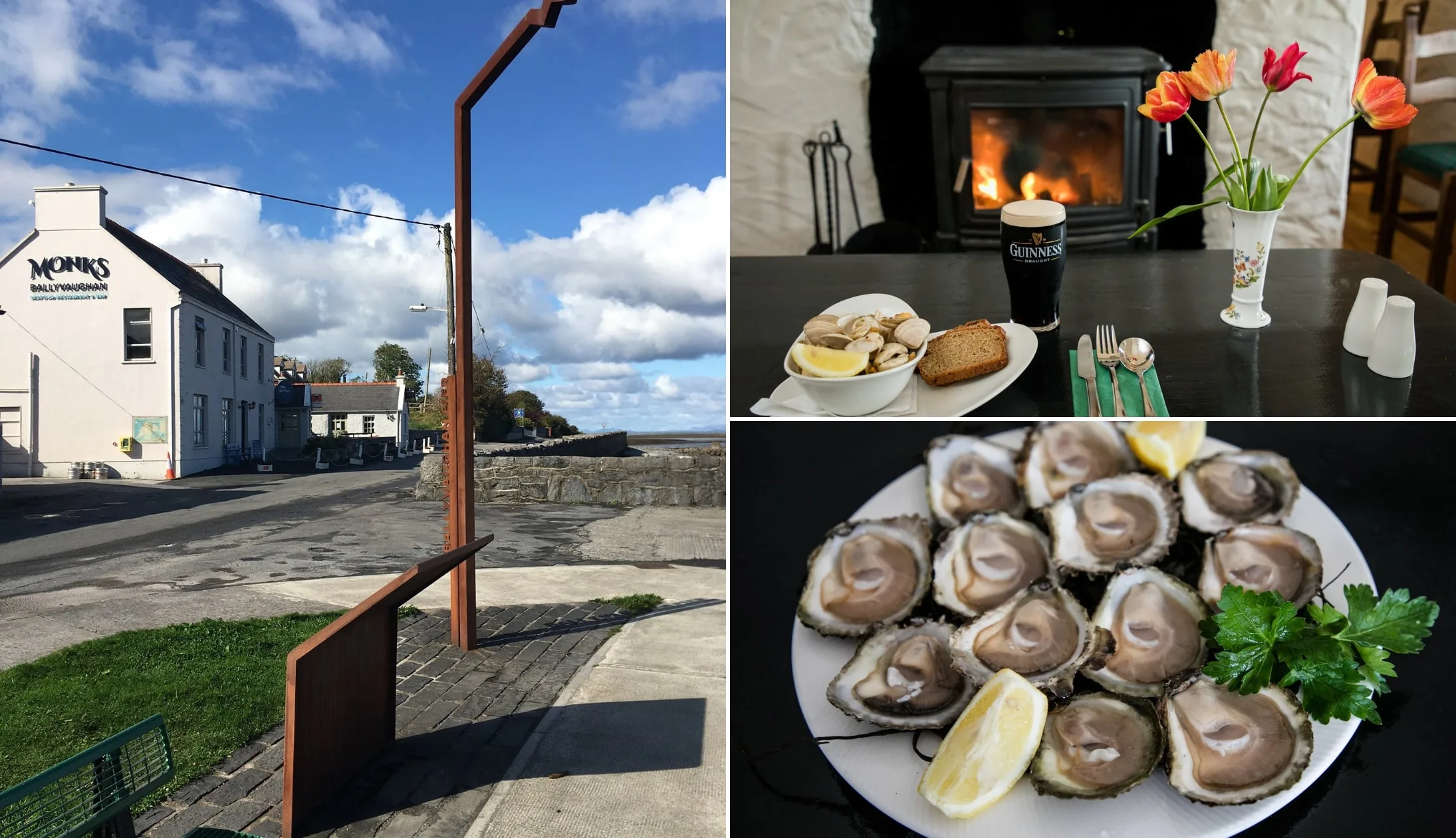
Photos via Monk’s on FB
It’s time to head to the quaint seaside village of Ballyvaughan, only 13 minutes from Poulnabrone Dolmen. Our favourite places to eat in the village are Monks (a brilliant seafood restaurant with handpicked Galway Bay oysters), The Wild Atlantic Lodge (a beautiful restaurant with delicious Irish cuisine), or The Larder (a cosy cafe with sandwiches, soup, and quiches).
Stop 5: Fanore Beach

Photos via Shutterstock
Fanore Beach is 18 minutes from Ballyvaughan. It’s a gorgeous beach backed by rolling sand dunes. The exposed beach is a popular spot for swimmers and surfers, and in the summer, there’s a lifeguard service and a surf school.
Take a scenic walk along the beach, and if you need to pop to the toilet after lunch, there are public toilets on-site (open seasonally in the summer).
Stop 6: Doolin

Photos courtesy of Chaosheng Zhang
The drive from Fanore Beach to Doolin usually takes around 25 minutes, but we would recommend giving yourself a little extra time.
There are some amazing views of the Burren along the way and you might want to pull over! Once you arrive at Doolin, check into your hotel and rest/freshen up/etc.
Stop 7: Cliffs of Moher

Photos via Shutterstock
Your next stop, the magnificent Cliffs of Moher are one of the area’s (if not Ireland’s) most popular attractions.
The cliffs are a 15-minute drive from Doolin, with breathtaking views of the wild Atlantic, Galway Bay, and the Aran Islands.
There’s a visitor centre on-site, as well as 800 metres of paved walkways with viewing areas, and the historic O’Brien’s Tower. In our opinion, the visitor centre isn’t really anything that special, but you’ll get access to all three with the Cliffs of Moher Experience.
Stop 8: Dinner, drinks and live music in Doolin
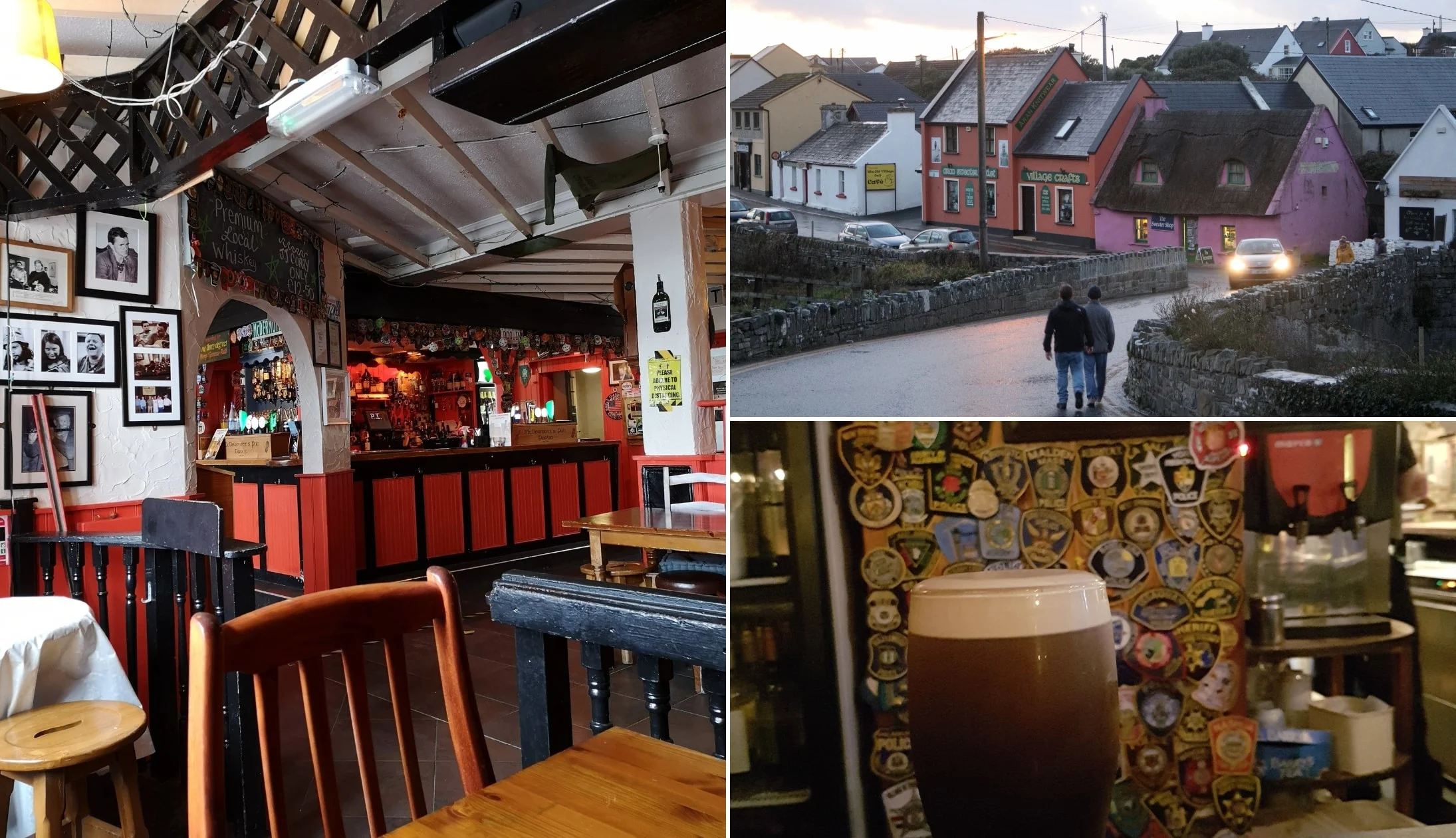
Photos by The Irish Road Trip
We have quite a few recommendations for where to eat in Doolin.
Although it’s fairly small, there’s some great restaurants in Doolin and there’s a handful of mighty pubs in Doolin, too.
Our Doolin food recommendations
We have quite a few recommendations for where to eat in Doolin. These are Riverside Bistro (the seafood pasta and lamb shank are delicious), Anthony’s at Doolin (modern Irish and international cuisine with a great selection of cocktails), and Russell’s Seafood Bar at Fiddle + Bow (amazing local seafood from award-winning chef Viv Kelly).
Our Doolin pub recommendations
Doolin is packed full of traditional Irish pubs which are great for a pint (or a hearty pub meal if the restaurants above aren’t to your liking). Our favourites are McDermot, McGanns, Fitz’s, and Gus O’Connors.
The pubs above are also a good place to catch some live music, as well as Anthony’s at Doolin.
Day 8: Inis Mor
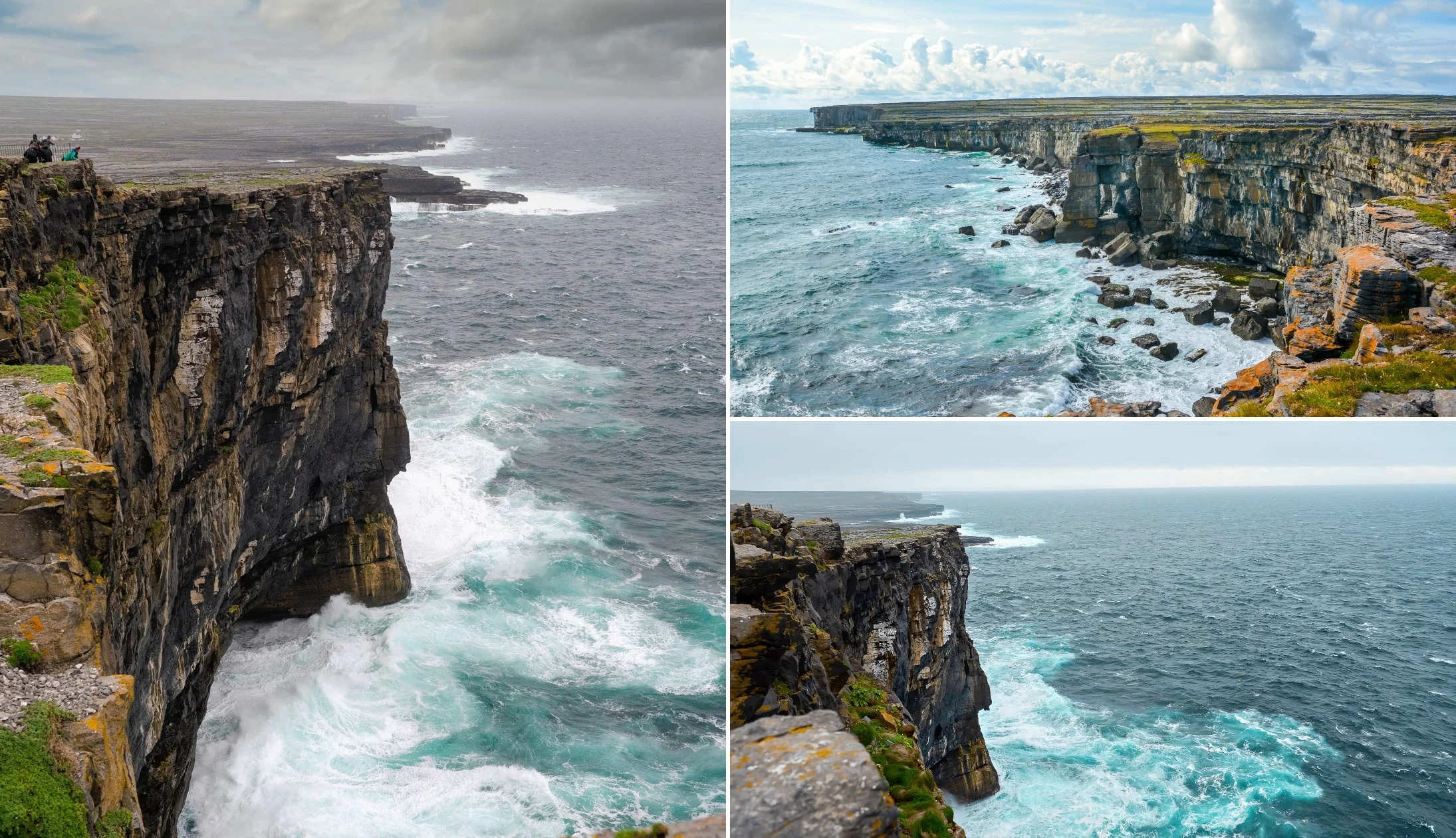
Photos via Shutterstock
Today’s a big day, as you’ll be heading off to explore Inis Mor, a beautiful island off the west coast of Ireland, and one of the Aran Islands, a chain of limestone islands rich in history.
Inis Mor is the largest of the Aran Islands at 31 km², with a population of around 800 people. Inis Mor’s residents are within the Irish-speaking Gaeltacht, and you’ll notice there’s a strong sense of Irish culture. The landscapes are incredible, with miles of stone walls and rugged coastline.
It’s going to be an adventure-filled day packed with walking and cycling, so make sure to wear appropriate clothes and pack for all types of weather!
Grab a hearty breakfast where you’re staying, or check out the Doolin Cafe or Gus O’Connor’s Pub.
Stop 1: Doolin Pier
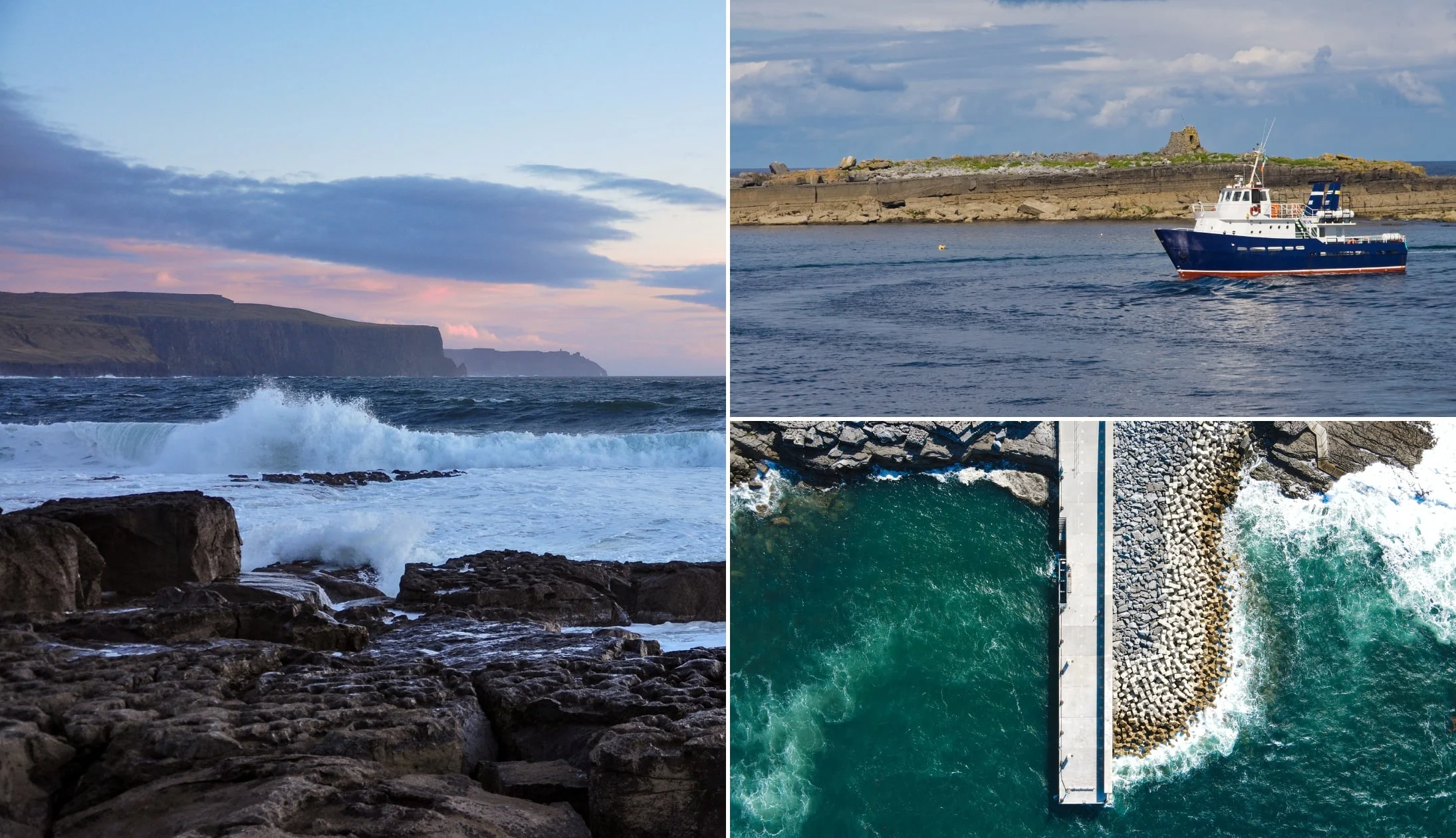
Photos via Shutterstock
There are two ferry services running to Inis Mor: the Doolin Ferry Co. and Doolin2Aran Ferries. We’ve used them both and are happy to recommend either!
The journey is generally 35 minutes long (via express boat) and the ferries run daily services. Just make sure to book your ticket in advance.
Stop 2: Arrive on Inis Mor and rent a bike or get on the bus
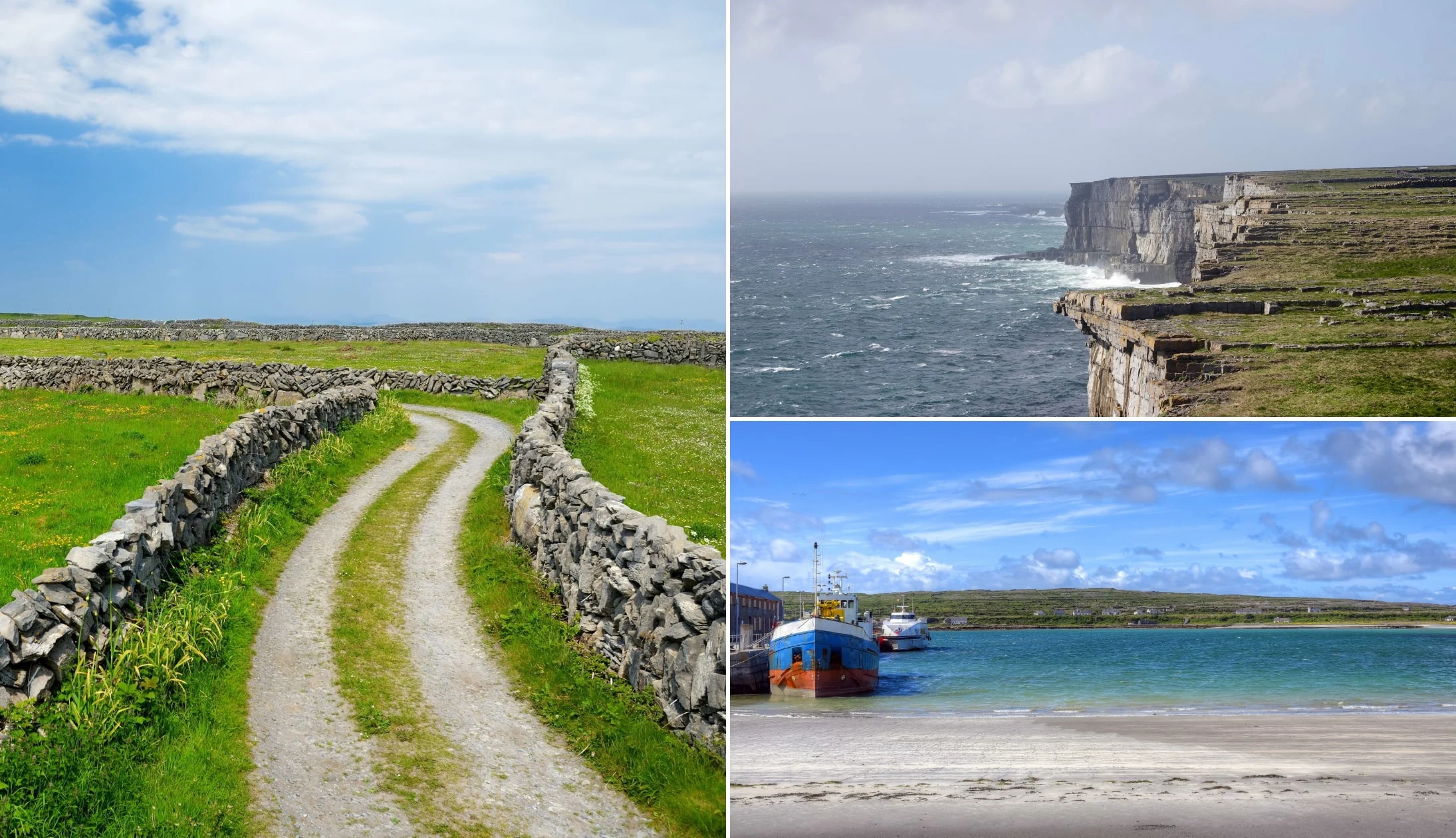
Photos via Shutterstock
We recommend either renting a bike (preferably an eBike), or if you don’t feel like being too active today, hopping on a mini bus tour when you arrive on the island.
Aran Bike Hire is right in front of the pier on the right and the most convenient place to hire a bike. They have a huge range of bikes on offer, such as mountain bikes (€20), electric bikes (€40), tandem bikes (€40), and children’s bikes (€10).
Inis Mor Bike Hire is further past the pier next to the tourist information centre. They have a range of regular bikes and ebikes, contact them via their website for up-to-date rates.
eBike Self Guided Tours is the furthest away, a six-minute walk from the pier. Their standard day rate is €20.
Stop 3: The Seal Colony
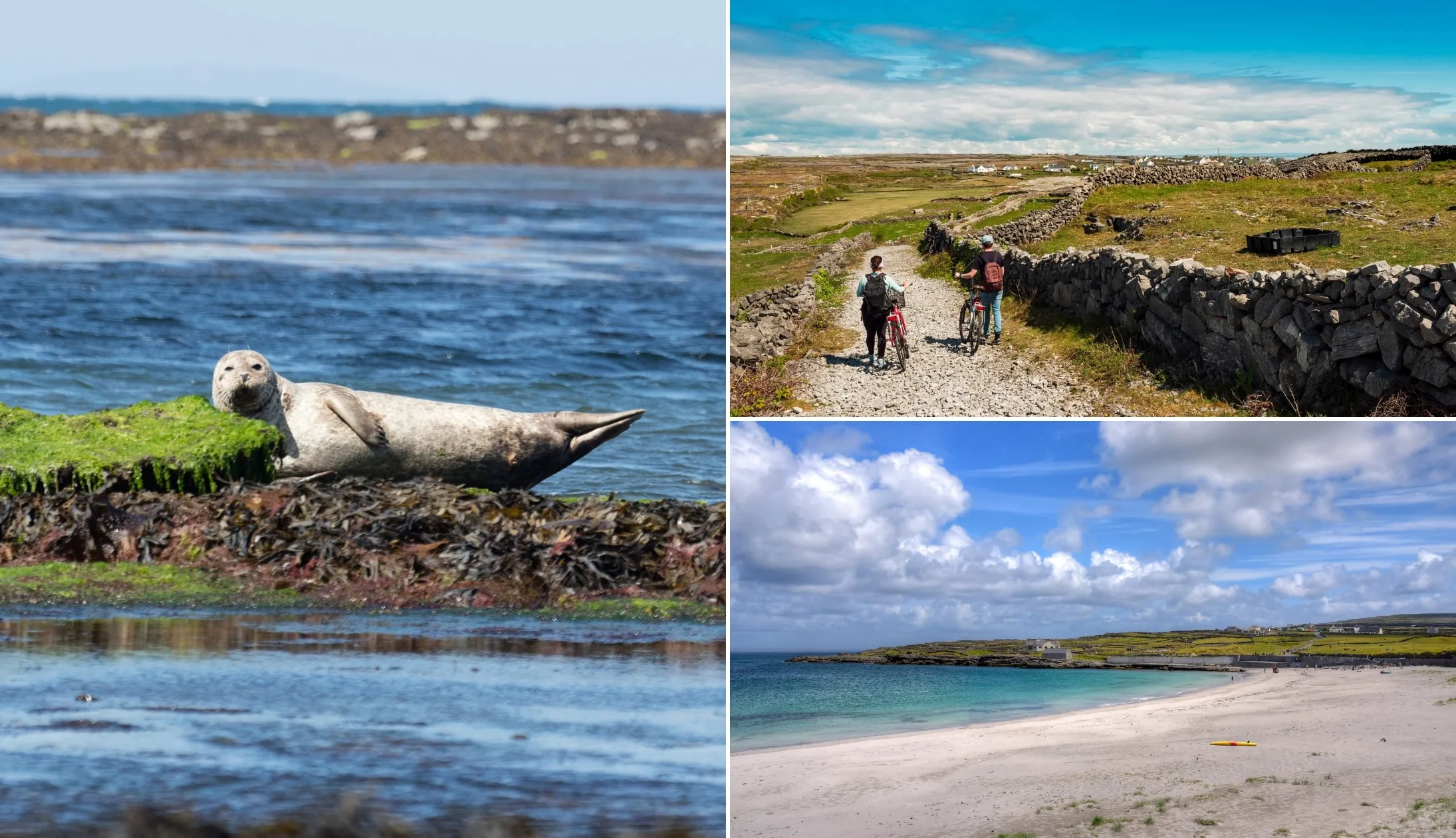
Photos via Shutterstock
From the pier, it’s 4.1km to the Seal Colony Viewing Point (around 15 minutes cycling). The island is home to a population of Atlantic Seals who live close to Kilmurvey Beach.
The viewpoint is easy to find, and during low tide, you can spot as many as a dozen seals sunbathing on the beach and rocks.
Stop 4: Dún Aonghasa

Photos via Shutterstock
After you’ve seen the colony, hop on your bike and cycle the 4.2km to the Dún Aonghasa Visitor Centre (around 10 minutes).
Dún Aonghasa is a prehistoric hill fort sitting on the edge of an 87-metre cliff. It’s not clear exactly how old the fort is, but parts of the fort date back to the Bronze Age and Iron Age. It’s the biggest fort on the Aran Islands with three impressive drystone defence walls.
You’ll need to park your bike at the ‘bike parking’ area (here on Google Maps), then walk the final 1km on foot.
There’s an incline approaching the fort and the last section is on rocky ground, so good shoes are a must. There’s no barrier at the edge of the cliff, so make sure to take extra care close to the edge.
Please note: The walk out to Dún Aonghasa may not suit those with low levels of fitness. If you don’t fancy the walk, head for a cup of coffee in the gorgeous Teach Nan Phaidi nearby.
Stop 5: The Worm Hole

Photos via Shutterstock
Also known as the Serpent’s Lair or ‘Poll na bPeist’, the Worm Hole is a one-of-a-kind natural tidal pool! What makes it so unique?
Well, its rectangular shape is 100% natural. It was featured in the 2017 Red Bull Cliff Diving Series and although it’s a little hard to find, it’s well worth the extra effort.
From Dún Aonghasa, the best way to visit The Worm Hole is to (carefully) make your way east along the cliffs. It’s roughly 1.6km with painted rocks marking the way.
Even though it may be tempting to go for a swim, we highly advise against it as there’s no easy way to get out of the pool if you get into trouble. The tidal pool also contains underwater currents, and depending on the tide and weather, waves can crash over the top.
Stop 6: Lunch

Photo left: Gareth McCormack via Failte Ireland. Others: Via Joe Watty’s
After the trek back to your bike, you must be hungry. For a small island, there are plenty of places to eat and some of our top picks are Joe Watty’s Bar, Bayview Restaurant, and Madigan’s Bar & Restaurant at the Aran Islands Hotel.
Both Joe Watty’s Bar and Bayview Restaurant are a good pick for families, with hearty Irish dishes, delicious seafood, and a children’s menu. Madigan’s Bar & Restaurant has a seasonal menu with light bites and a lovely outdoor seating area overlooking the water.
Stop 7: Black Fort
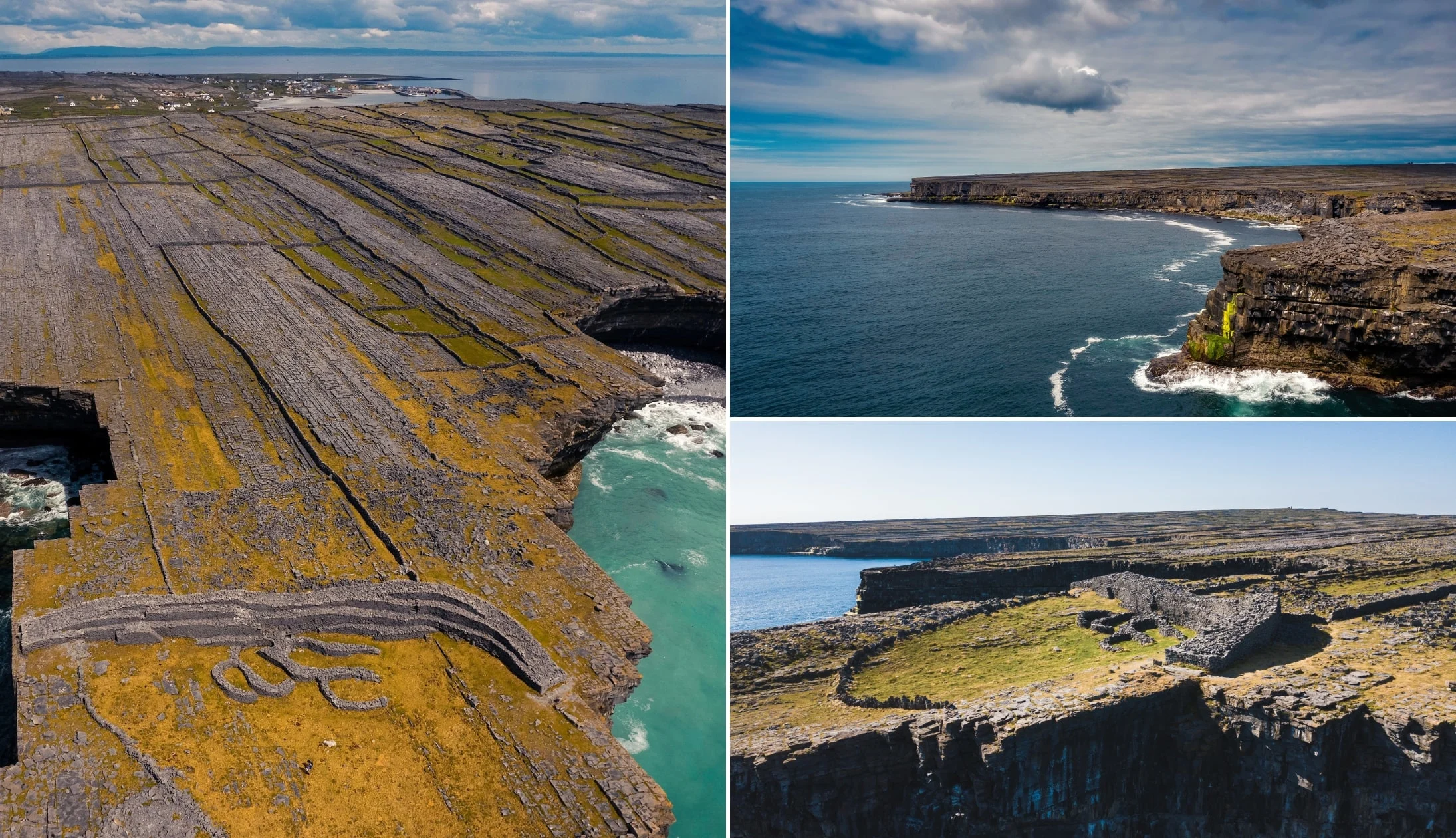
Photos via Shutterstock
Dún Dúchathair, or the Black Fort, is an ancient fort 2.7km (roughly eight minutes cycling) from Kilronan. The fort is near a cliff edge and it’s thought that it gets its nickname thanks to the cliff’s dark limestone which is characteristic of the area.
The site has terraced stone walls that surround the Clocháns (stone dwellings). Similarly to Dún Aonghasa, it’s not clear just how old the Black Fort is, but it’s believed to be built around the same time.
The way is clearly signposted and easy to find, but before you reach the fort, the paved road ends and the terrain becomes rockier. Most people choose to leave their bikes at the side of the road and proceed on foot. There’s no barrier or fence at the cliff edge, so once again, take extra care close to the cliffs.
Stop 8: Back to Doolin for dinner, drinks and live music

Photos by The Irish Road Trip
Get the ferry back to Doolin and chill for the evening.
Although it’s fairly small, there’s some great restaurants in Doolin and there’s a handful of mighty pubs in Doolin, too.
Our Doolin food recommendations
We have quite a few recommendations for where to eat in Doolin. These are Riverside Bistro (the seafood pasta and lamb shank are delicious), Anthony’s at Doolin (modern Irish and international cuisine with a great selection of cocktails), and Russell’s Seafood Bar at Fiddle + Bow (amazing local seafood from award-winning chef Viv Kelly).
Our Doolin pub recommendations
Doolin is packed full of traditional Irish pubs which are great for a pint (or a hearty pub meal if the restaurants above aren’t to your liking). Our favourites are McDermot, McGanns, Fitz’s, and Gus O’Connors.
The pubs above are also a good place to catch some live music, as well as Anthony’s at Doolin.
Day 9: Limerick City
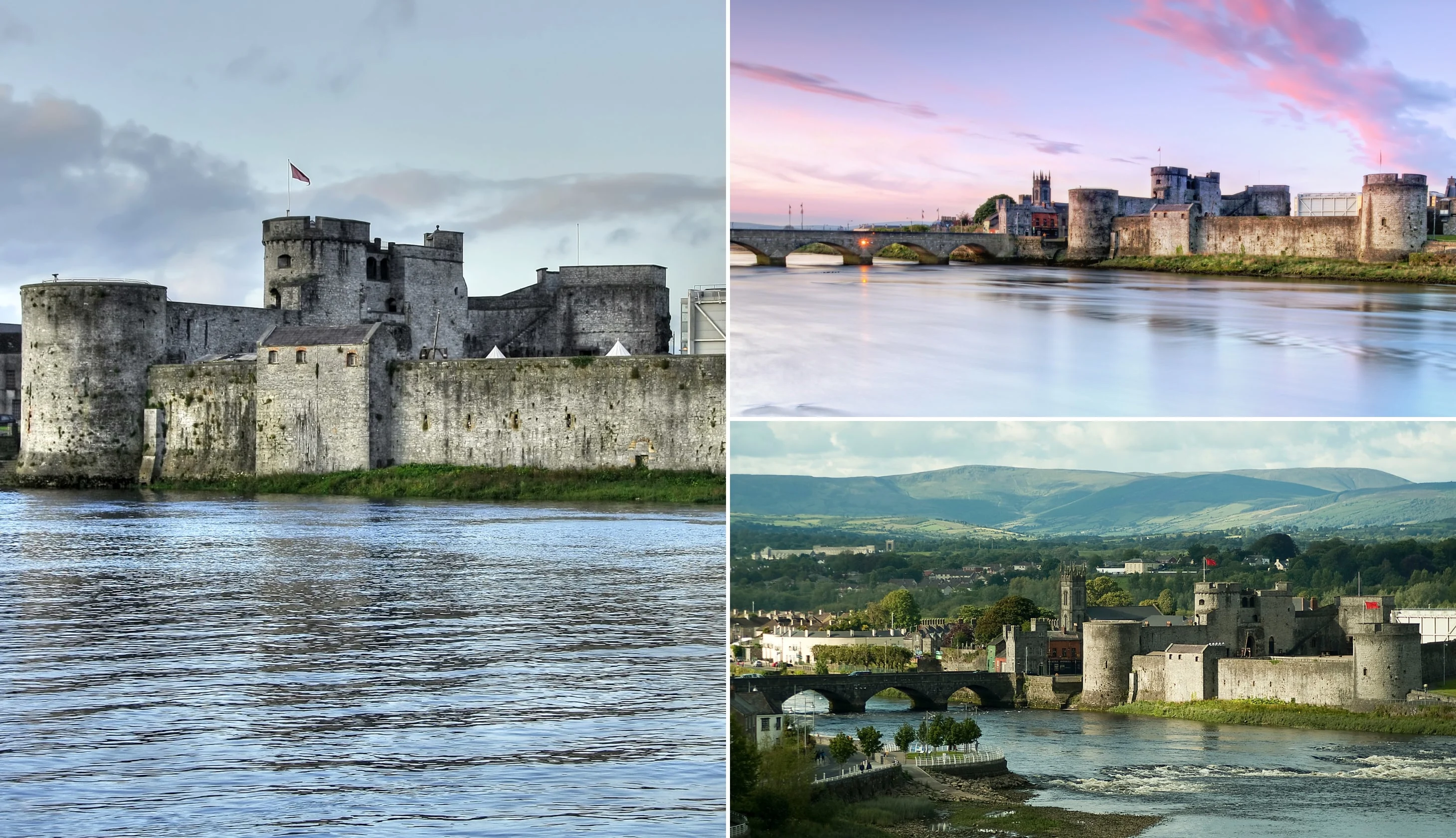
Photos via Shutterstock
Today we are heading from Doolin to Limerick where we will spend one night before heading off to Athlone.
Grab a hearty breakfast before you check out or find somewhere nearby to eat. Then, make sure the car is fueled up and hit the road!
Recommended accommodation in Limerick
- Budget: Woodfield House Hotel (15-minute walk from the city with excellent reviews) and Shelbourne House (cosy spot 20 minutes walk from the castle)
- Mid-range: Limerick City Hotel (very central hotel near the river) and The Bedford (very central boutique townhouse with exceptional reviews)
- Luxury: The Savoy Hotel (central, boutique 5-star) and The George (central spot on O’Connell Street in Limerick city centre)
Stop 1: Clare Abbey

Photos via Shutterstock
Clare Abbey is a 46-minute drive from Doolin. Although the abbey is now in ruin, it was once the largest and most important Augustinian monastery in the county. It was built in 1189 on what was possibly the site of an earlier church, and in 1278, it was the site of a battle between Toirdhealbhach Mór Ó Briain and Thomas de Clare during a civil war.
Today, all that remains are a church and belfry, plus a few domestic buildings to the south and east of the church, surrounded by a cloister. It’s an interesting historical site to visit, and it’s free. Take care if it has rained as it can get very muddy.
Stop 2: Bunratty Castle and Folk Park

Photos via Shutterstock
Bunratty Castle and Folk Park sit on 26 acres of lovely countryside around one hour from Doolin (grab your skip-the-line ticket online before you go).
Visiting the Folk Park feels like stepping back in time as the 19th-century buildings and streets have been recreated to resemble what they would have originally looked like.
The park has over 30 buildings, including village shops, rural farmhouses, and Bunratty House, a beautiful Georgian home.
You can also take a tour of 15th-century Bunratty Castle, the last of four castles built on the site. However, prior to the castles being built, the site was home to a Viking trading camp in 970.
Stop 3: Lunch in Limerick
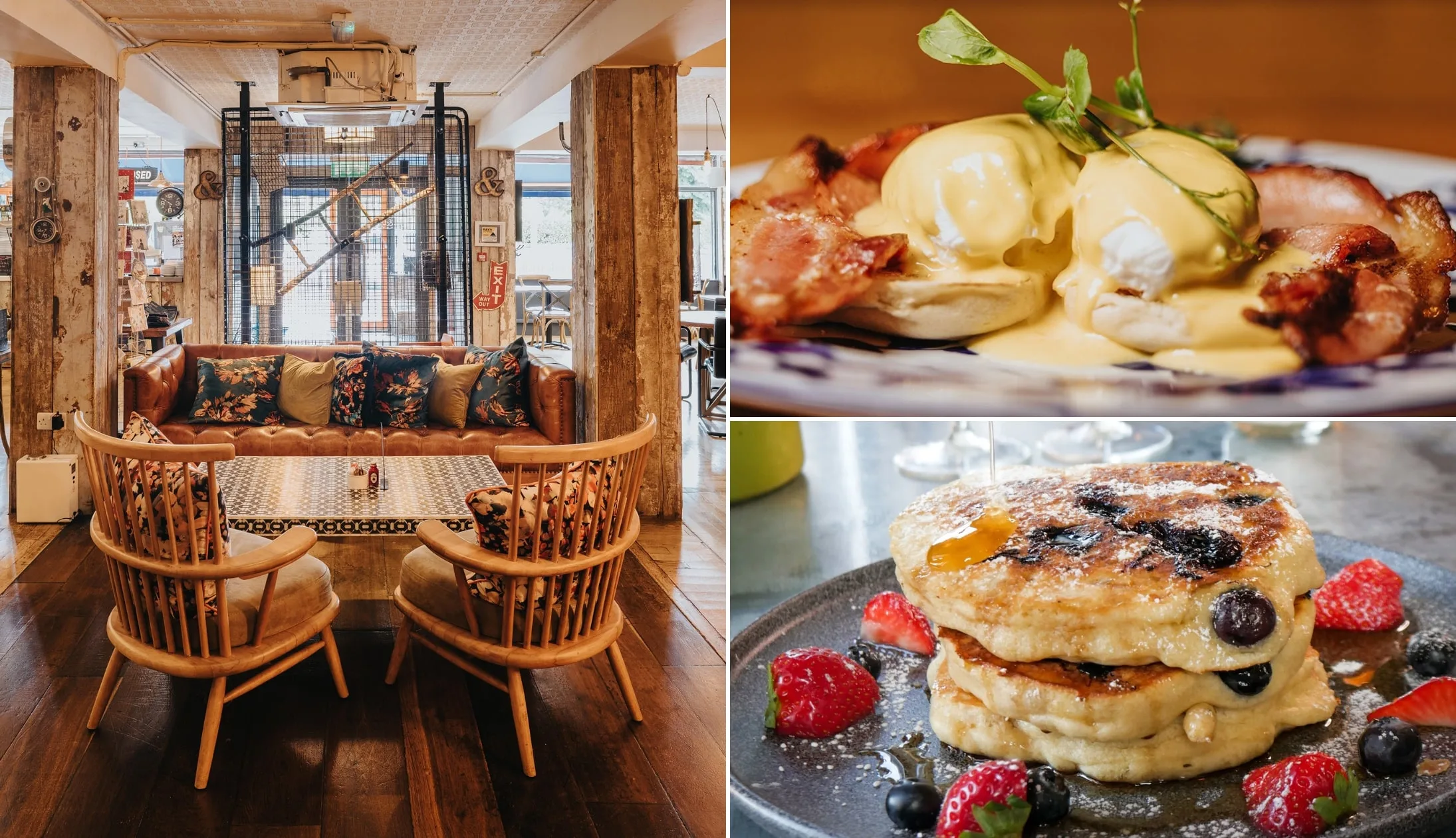
Photos via Hook and Ladder on FB
Welcome to Limerick! It’s around 20 minutes from the folk park, and once you arrive, park the car and head out to explore the city on foot.
It’s probably close to lunchtime by now, and we’ve got a couple of suggestions for you. We usually head to Coqbull, The Buttery, or the Hook and Ladder when we’re in the city. Coqbull is a casual dining restaurant, serving up top-notch burgers and wings. The Buttery is our go-to for brunch, and the Hook and Ladder (the one on Sarsfield Street) has delicious sandwiches and a mouth-watering vegan burger.
Stop 4: King John’s Castle

Photos via Shutterstock
Head off to King John’s Castle, a 10-minute walk from the centre of the city. The 13th-century castle sits on King’s Island, on the banks of the River Shannon. The castle is in fantastic condition and is one of Europe’s best preserved-Norman castles.
King John’s Castle was built under the orders of King John, the “Lord of Ireland” and Richard the Lionheart’s brother. It was built between 1200 and 1212, with numerous repairs and extensions over its 800-year history.
The castle was a military stronghold, with solid curtain walls, turrets, and strong fortifications. However, despite this, it sustained heavy damage during the 1642 siege of Limerick (the first of five Limerick sieges during the 17th century). There’s a fantastic exhibition on the siege inside the castle if you’d like to learn more.
Most people spend around one and a half hours visiting the castle and visitor centre. You can have a look at the interactive exhibits, try on historical costumes, and in the summer, play Medieval games in the courtyard!
Stop 5: St Mary’s Cathedral

Photos via Shutterstock
The next stop is St. Mary’s Cathedral. It’s a three-minute walk from King John’s Castle, and you probably passed it on your way to the castle. The cathedral was founded in 1168, making it even older than King John’s Castle and the oldest building in Limerick that’s still in use today!
The cathedral contains six chapels, but if you’re pressed for time, the Lady Chapel is a must-visit. The Lady Chapel contains its original pre-reformation altar, which is four metres long and weighs three tons. During the mid-1600s, the altar was removed and dumped by Oliver Cromwell’s troops when they captured the city. But, by some miracle, it was recovered in the 1960s and reinstated to its rightful place.
Another highlight of St. Mary’s Cathedral is its misericords (small wooden carvings). They are the only complete set in Ireland and the only remaining pre-Elizabethan carvings.
Stop 6: The Hunt Museum
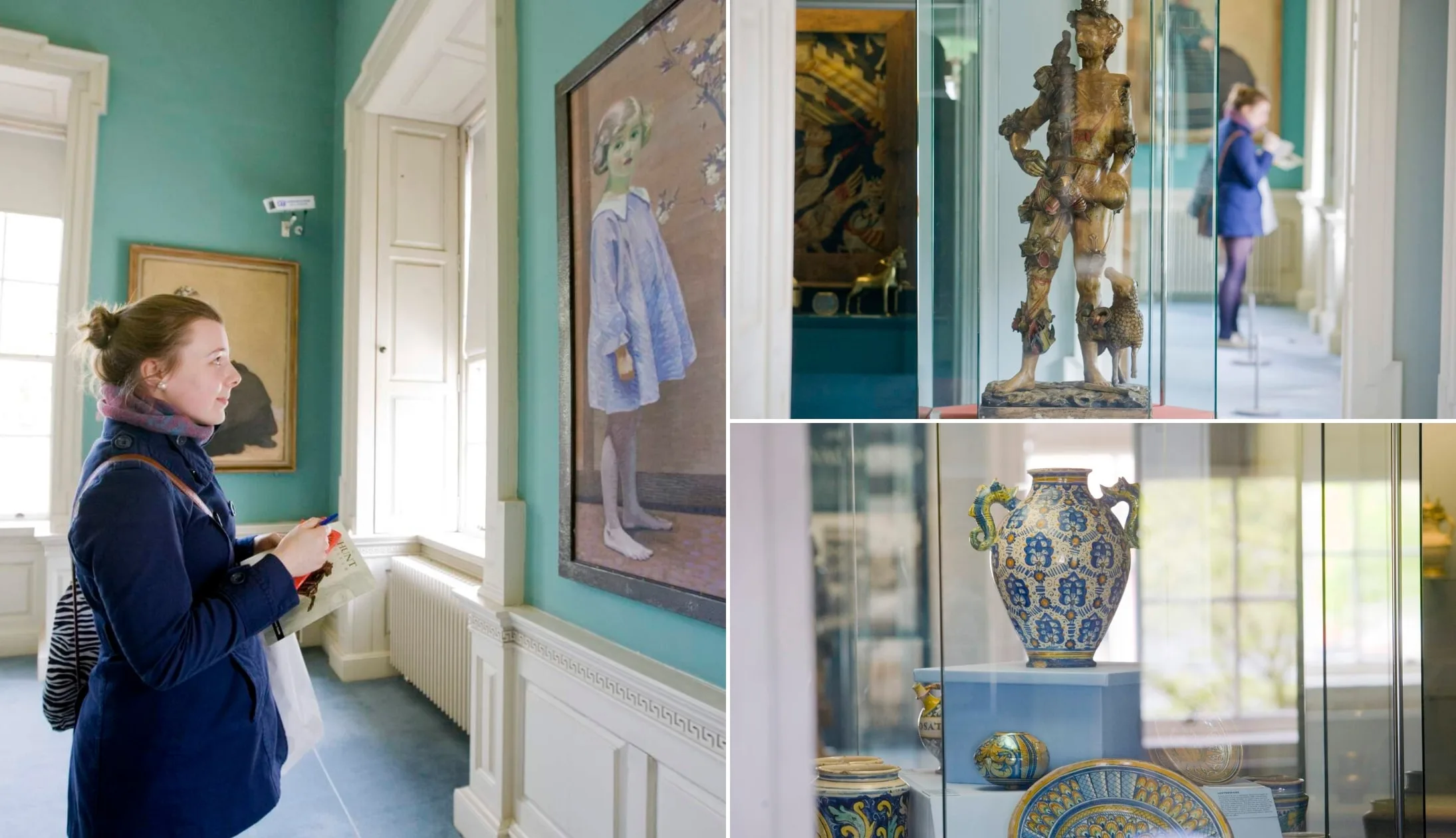
Photos via Tourism Ireland’s Content Pool
It’s time to walk another three minutes to the Hunt Museum. Again, you probably already passed it on your way to the castle.
The Hunt Museum was established after John and Gertrude Hunt decided to donate items from their personal collection to the people of Ireland.
The museum has a large collection with over 2,500 artefacts, including pieces from Ancient Egypt and Stone-Age Ireland.
Highlights of the collection include works by Picasso and dresses by famous Irish fashion designer Sybil Connolly.
Recently, the museum launched the “Museum in a Garden”, a beautiful garden dotted with 3D printed replicas of historical artefacts (get your ticket online here).
Stop 7: Dinner, drinks and live music
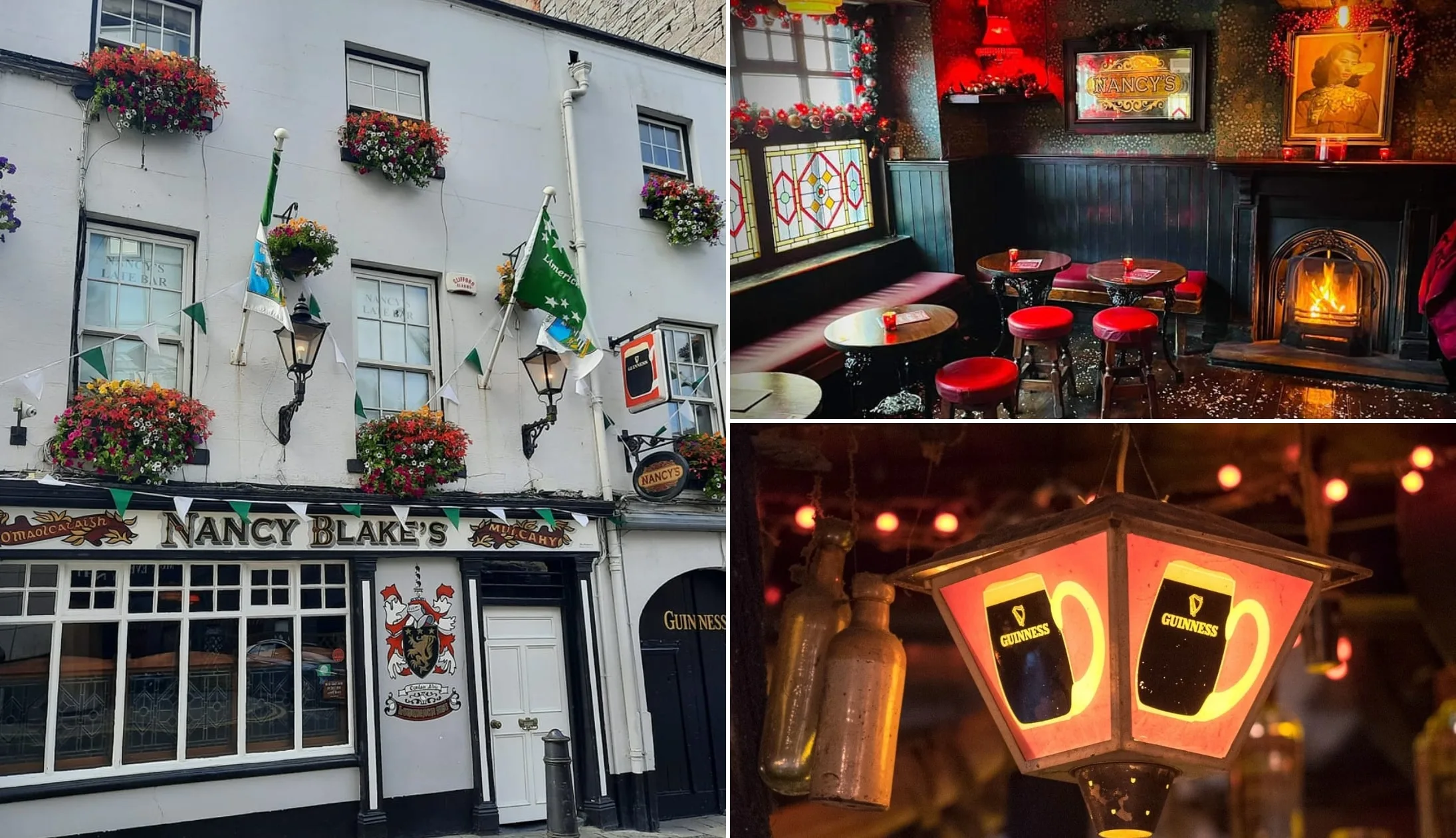
Photos via Nancy Blakes on FB
There’s some excellent restaurants in Limerick and there’s some mighty old-school pubs in Limerick, too.
Our Limerick food recommendations
Our absolute favourite spot for dinner is the Curragower. It’s right on the banks of the River Shannon with beautiful views of King John’s Castle across the water.
Grab some delicious pub grub like the roasted lamb rump or the lightly breaded scampi, then stick around for some pints after dinner.
Otherwise, we also like SpitJack (the rotisserie pork belly is a customer favourite) and The Locke (they have a delicious steak and ale pie and great vegetarian options).
Our Limerick pub recommendations
For drinks, again, we love the Curragower but Tom Collins is another lovely pub.
Another great trad pub is Nancy Blakes and depending on the night, they might have some music on.
However, if you don’t mind heading a little out of the city centre, then Charlie Malones is a must-visit. In our opinion, it’s one of Limerick’s best-kept secrets, with a real old-school pub vibe.
Limerick is a great city for trad music. The Locke often has music and even dancing on some nights if you’re lucky! Dolans is also great, but it’s a short walk from the city centre.
Day 10: Athlone
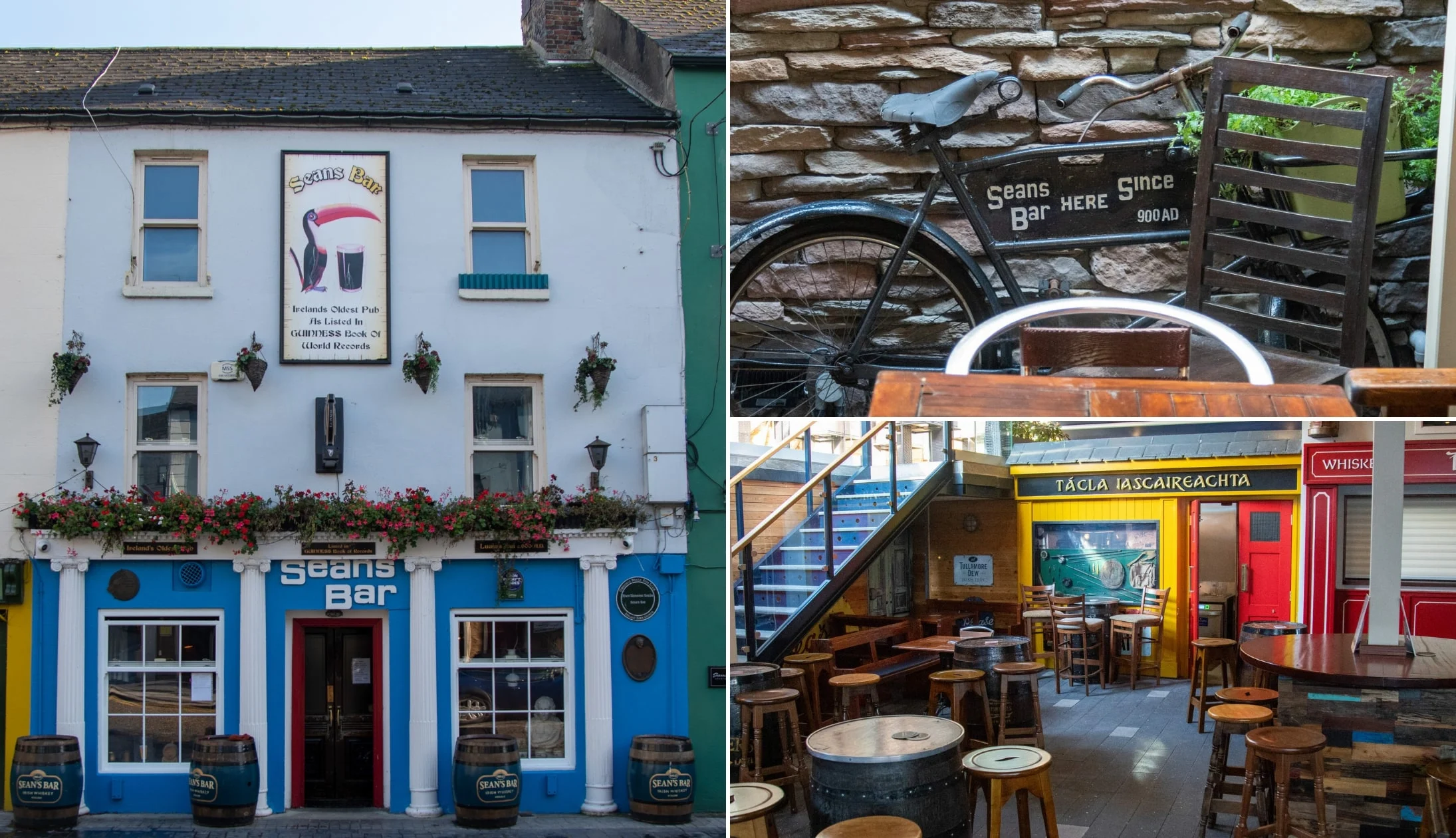
Photos courtesy Sonder Visuals via Ireland’s Content Pool
Today you’ll be heading to historic Athlone, where you will spend your last night in Ireland.
Grab some breakfast at your accommodation or nearby and then hit the road. The drive to Athlone takes around 1.5 hours.
Our Athlone accommodation recommendations
- Budget: The Bailey (no-fuss B&B right in the town) and Riverview House (10-minute drive from town with superb reviews)
- Mid-range: Radisson Blu and Sheraton Athlone (both super central with excellent reviews)
- Luxury: Glasson LakeHouse (very unique accommodation a 20-minute drive from town)
Stop 1: Athlone Castle
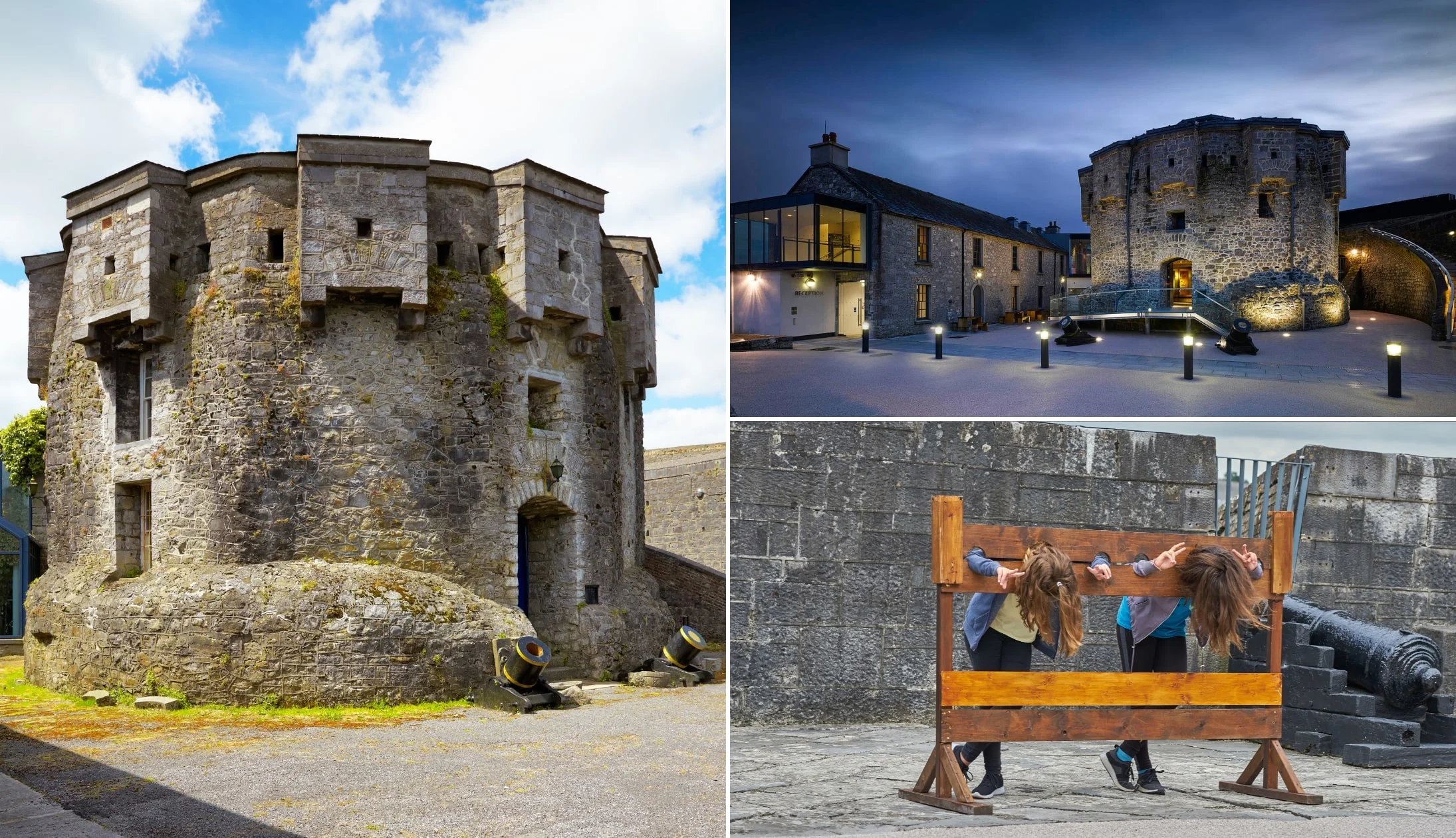
Top right photo: Ros Kavanagh via Failte Ireland. Others: Shutterstock
Athlone Castle is in the centre of Athlone on the banks of the River Shannon. There are two public car parks around the castle, as well as plenty of street parking if these get full (see parking here and here on Google Maps).
The stone castle is in great condition and dates back to the 13th century. It was in a key strategic position for defending the Athlone river crossing and played an important part in the infamous Siege of Athlone.
The visitor centre is full of information about the castle’s history, with eight exhibitions.
Stop 2: Lunch

Photos via Beans & Leaves on FB
By now you must be getting hungry, so enjoy a hearty lunch at Craft Bistro, Loaves and Fishes, or Bean and Leaves.
Stop 3: Church of St. Peter and St. Paul

Photos via Shutterstock
The Church of St. Peter and St. Paul is just across from Athlone Castle. It’s a beautiful Roman Catholic Church built in the Baroque-revival style between 1932 and 1939.
It’s most well-known for its stunning stained-glass windows that were made in the Harry Clarke workshop. Head inside if you can and admire Saint Joseph, Saint Patrick, Last Judgement, and Purgatory windows.
Stop 4: Luan Gallery

Photos courtesy Sonder Visuals via Failte Ireland
The Luan Gallery is literally across the street from the church, less than a one-minute walk away. The contemporary art gallery sits on the banks of the River Shannon, with works on display from some of Ireland’s top artists, as well as international artists.
It’s an ever-changing collection that changes every two months, so it’s always fresh and exciting! You’ll find a mixture of sculptures, classic paintings, and mixed media pieces.
Stop 5: Dinner, drinks, and live music

Photos courtesy Sonder Visuals via Ireland’s Content Pool
Head to your accommodation to check in (if you didn’t already) and freshen up before dinner.
Our Athlone food recommendations
We’ve got a couple of stellar recommendations for your last night in Ireland.
For something special, choose Thyme for dinner, a restaurant featured in the Michelin Guide. Their menu features modern Irish cuisine, with dishes like ham hock, celeriac, and crispy hen’s egg, or goat loin, confit belly, pressed shoulder, asparagus, hen of the woods, and wild garlic. They also have a value menu if your budget is feeling a little tight at the end of the trip.
For classic Irish and fusion cuisine, we like Bacchus. They have a delicious seafood casserole and more imaginative dishes like Tandoori roast lamb rump.
Our Athlone pub recommendations
For post-dinner drinks, Sean’s Bar is a must. It’s Ireland’s oldest pub and is officially recognized by the Guinness Book of World Records. Inside, it’s got traditional decor and a great atmosphere. They do a cracking pint of Guinness but even if you’re not a drinker, it’s worth visiting this historical pub.
Other spots we like for post-dinner drinks are Peddler Mac, The Snug Bar, and Nuts Corner.
Head to our recommendations above for live music, although you may have to pick and choose based on who’s got live music going on that night.
Day 11: Back to Knock and home
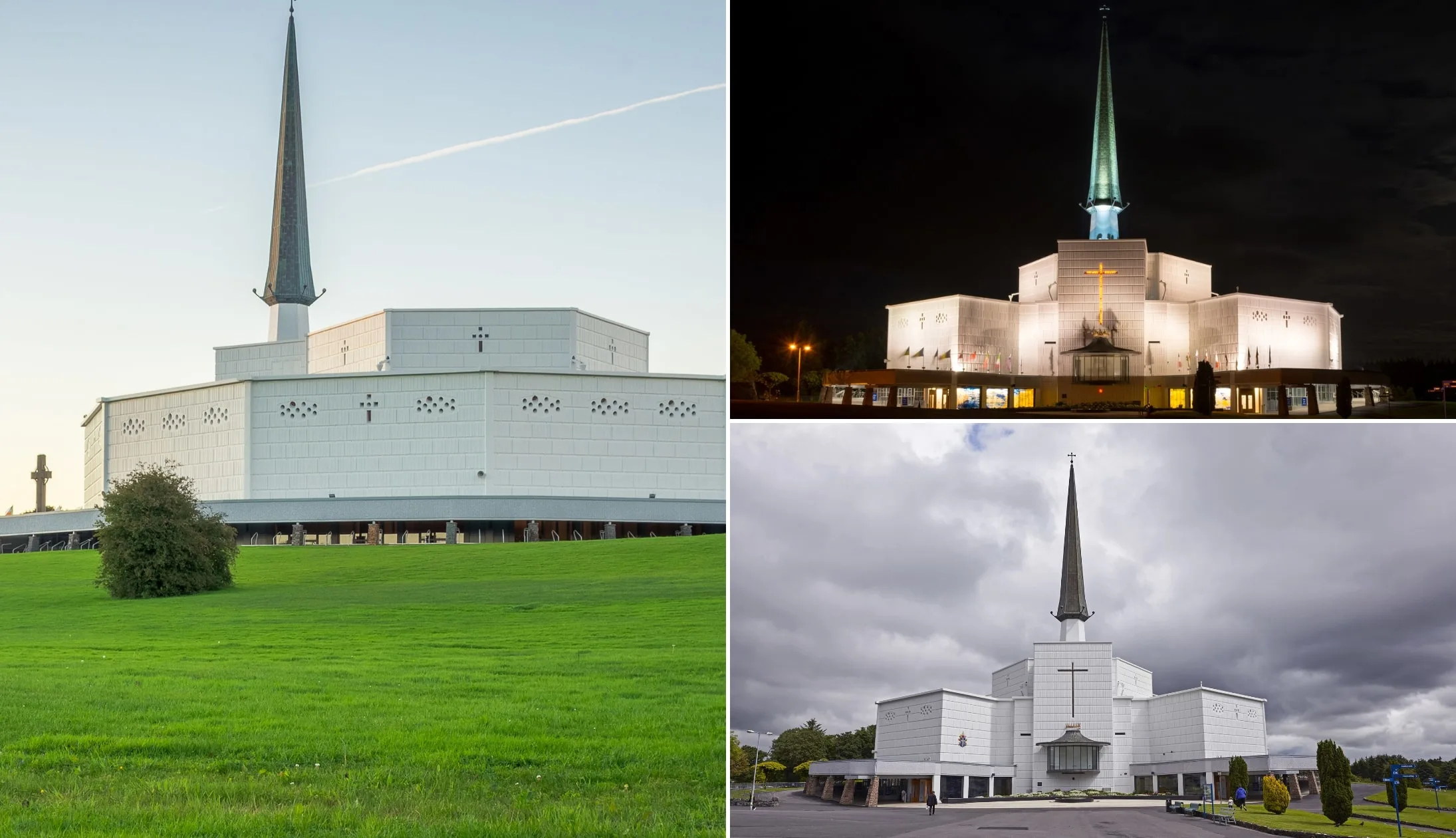
Photos via Shutterstock
And that’s the end of your whirlwind trip to Ireland! Depending on what time your flight leaves, you may have to head out early or have some more time to explore before you drive to Knock Airport.
The airport is approximately an hour and 20 minutes away, so make sure to give yourself plenty of time to catch your flight!
And that’s a wrap on this road trip
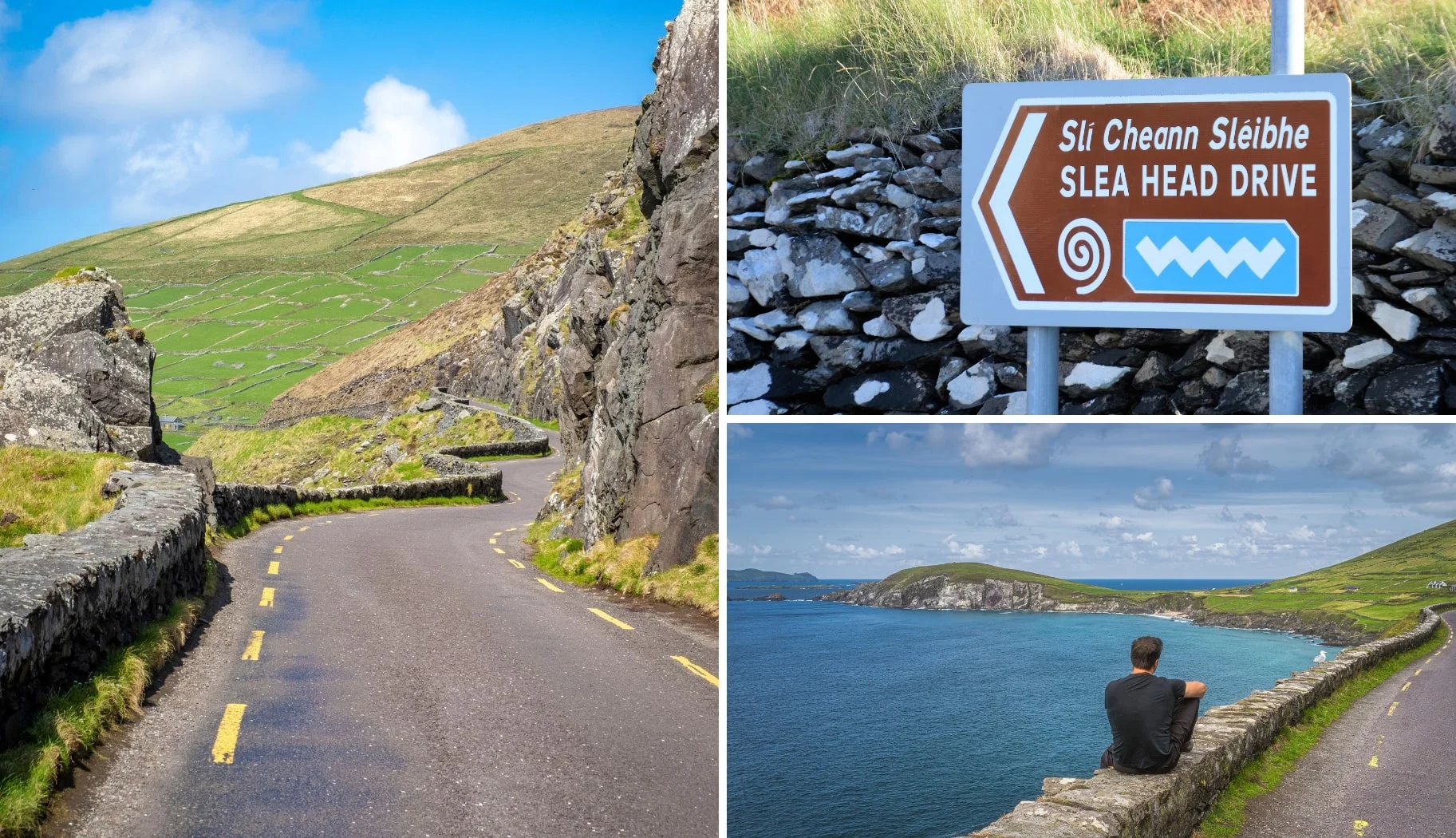
Photos via Shutterstock
We hope you found the above road trip guide useful. If you have any questions, ask in the comments below and we’ll do our best to help.
Or, if you’d like to browse our other Irish Road Trip itineraries, visit our Road Trip Hub – cheers!
Keith O’Hara has lived in Ireland for 35 years and has spent most of the last 10 creating what is now The Irish Road Trip guide. Over the years, the website has published thousands of meticulously researched Ireland travel guides, welcoming 30 million+ visitors along the way. In 2022, the Irish Road Trip team published the world’s largest collection of Irish Road Trip itineraries. Keith lives in Dublin with his dog Toby and finds writing in the 3rd person minus craic altogether.

